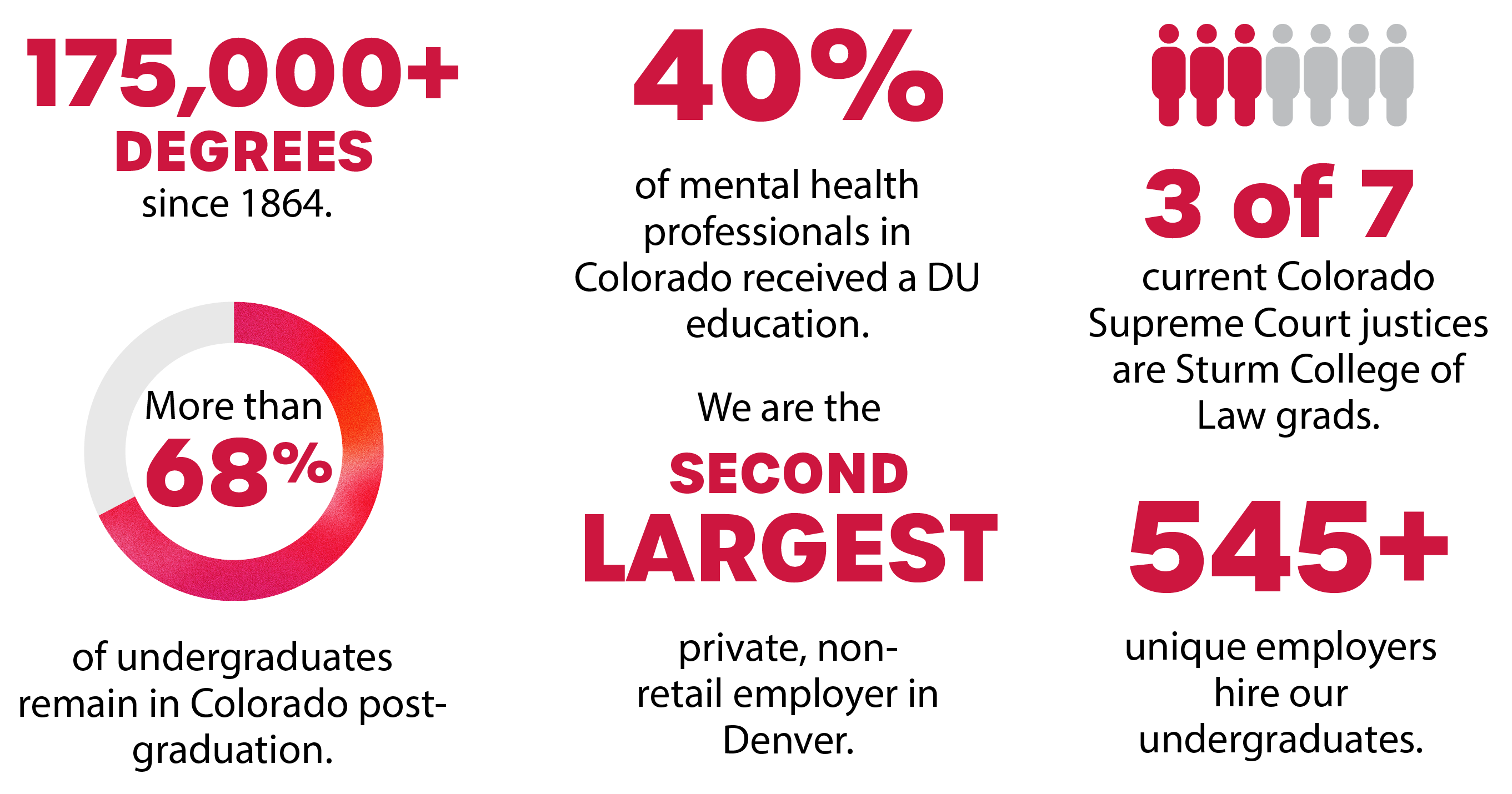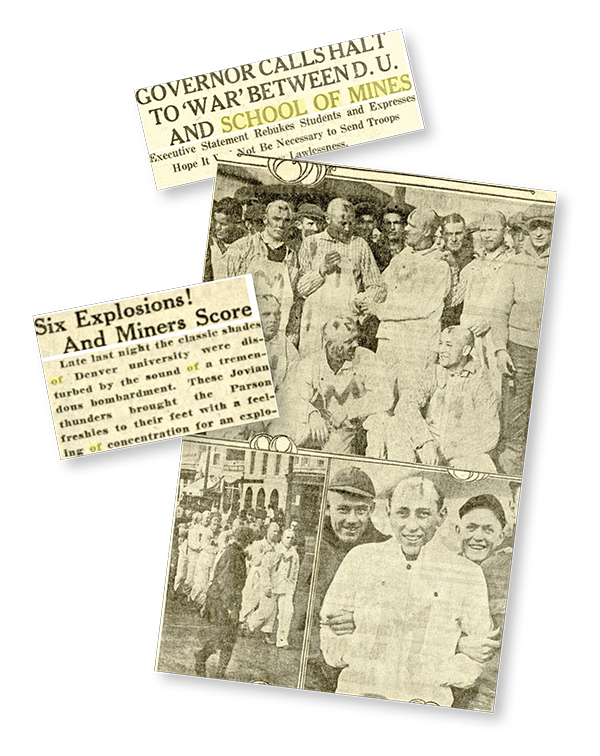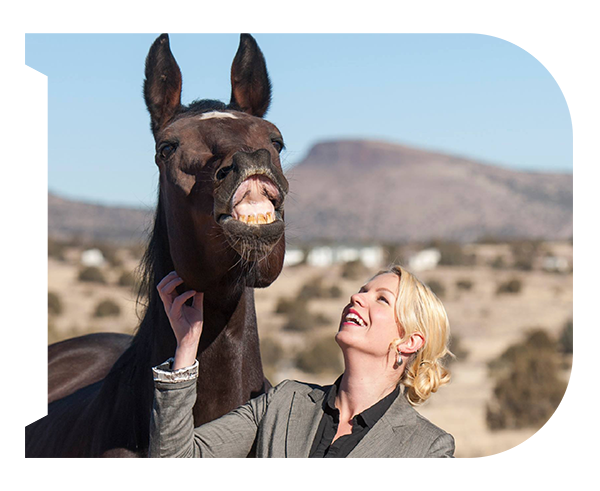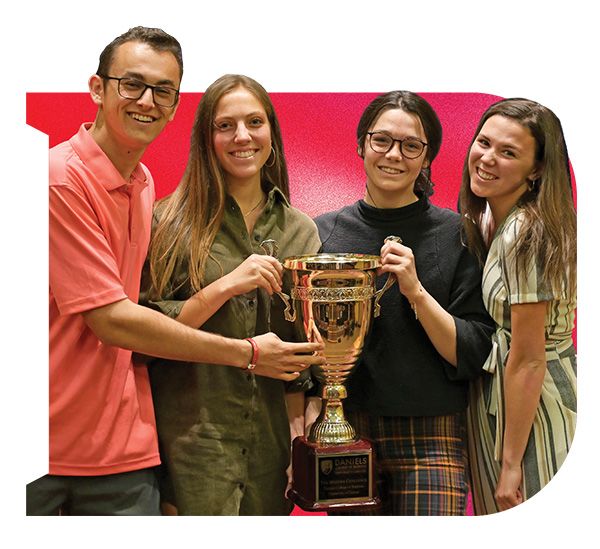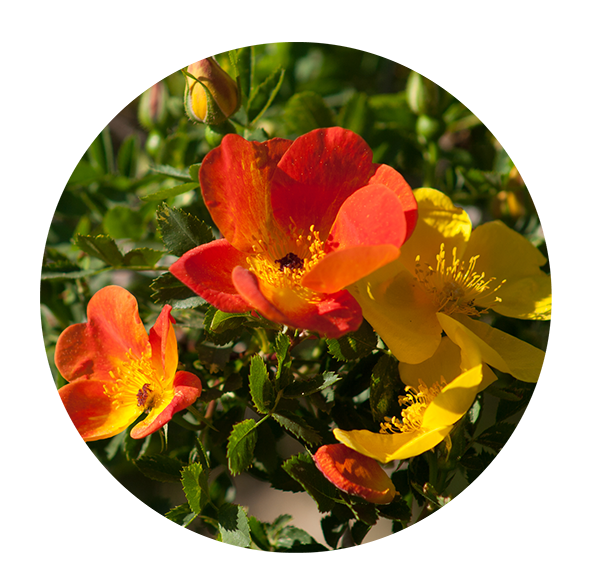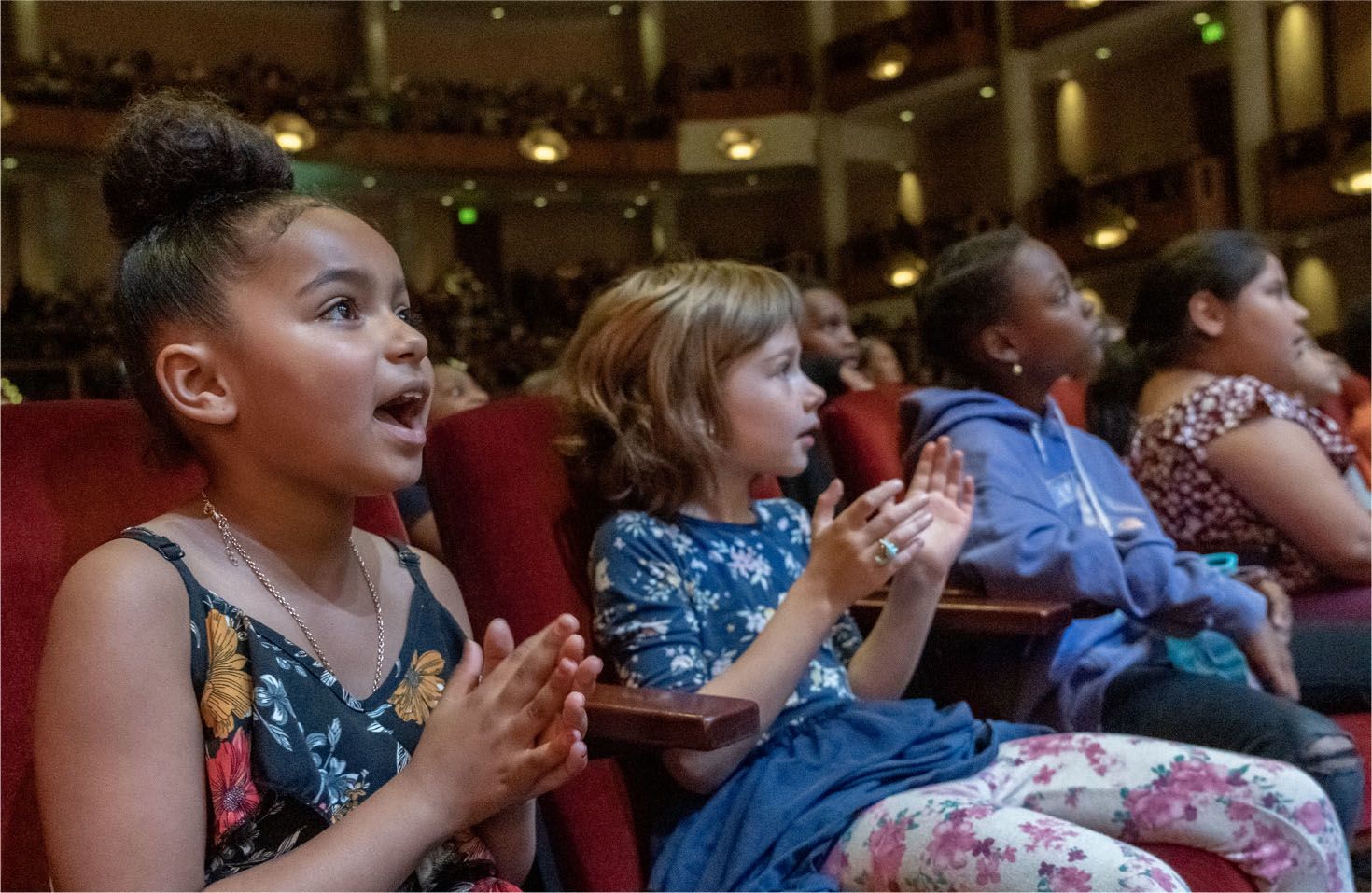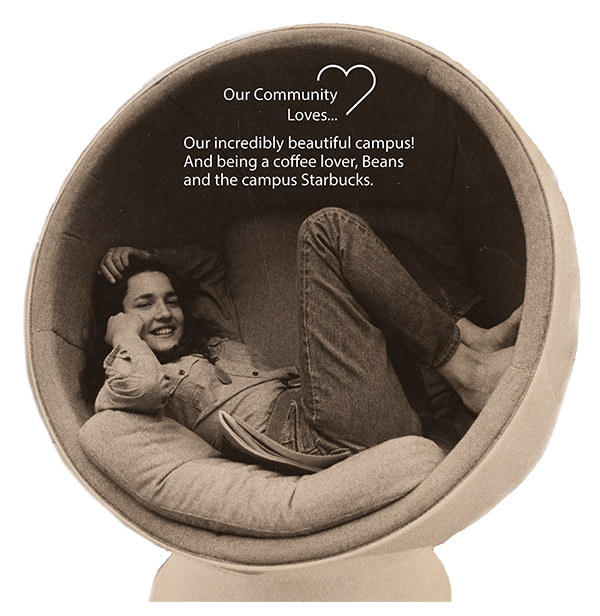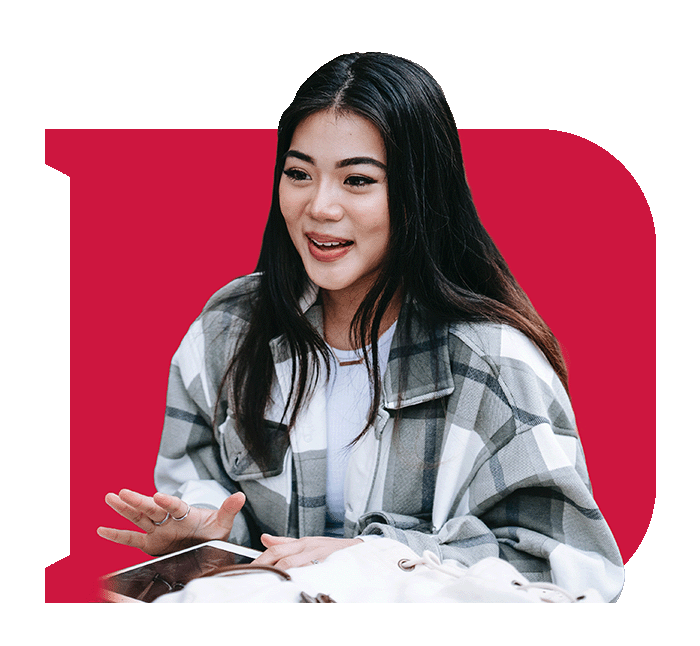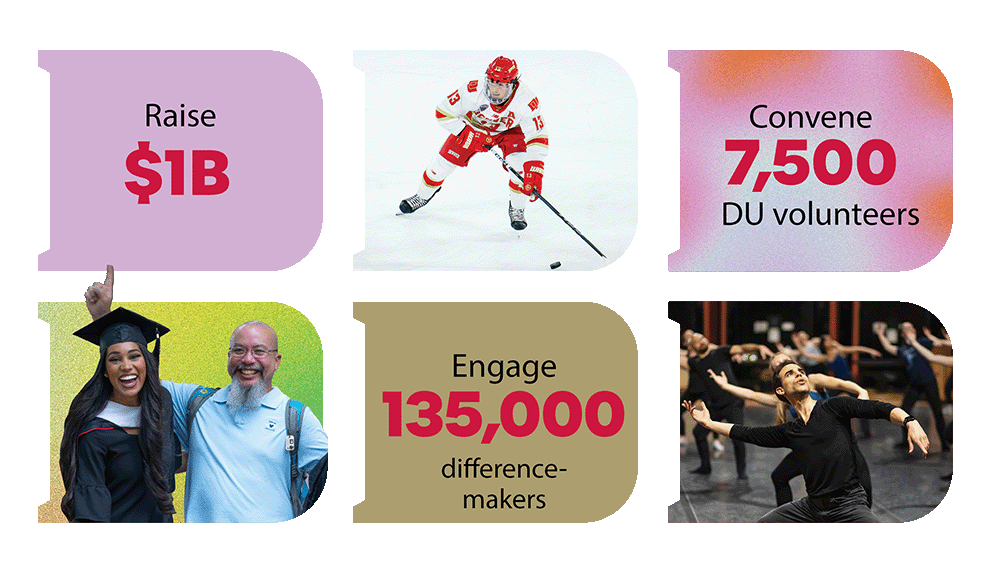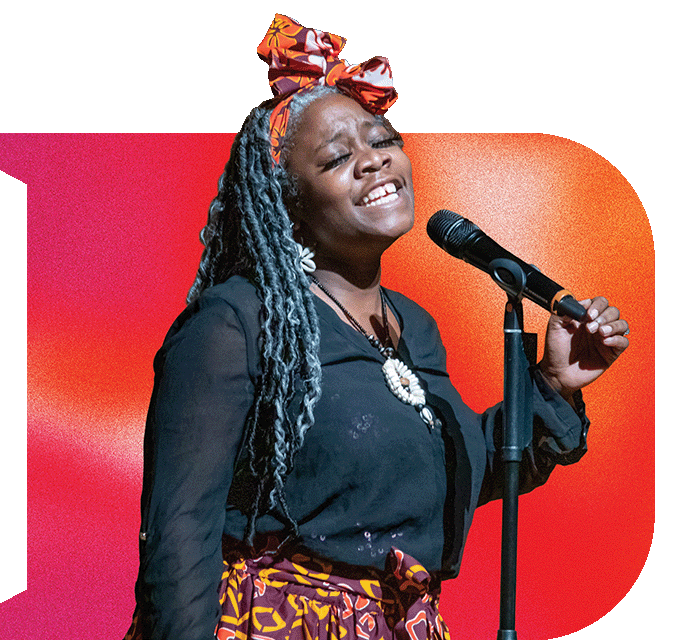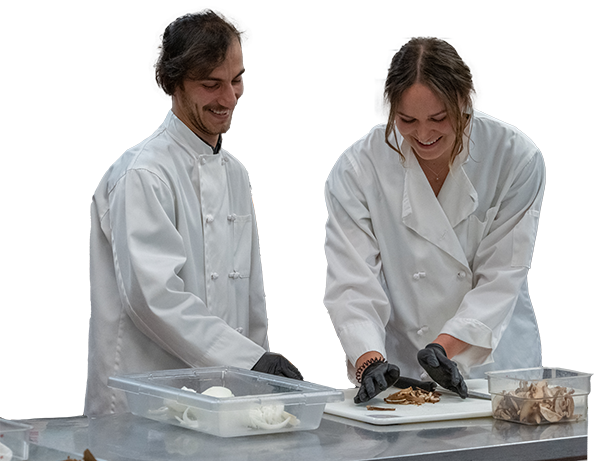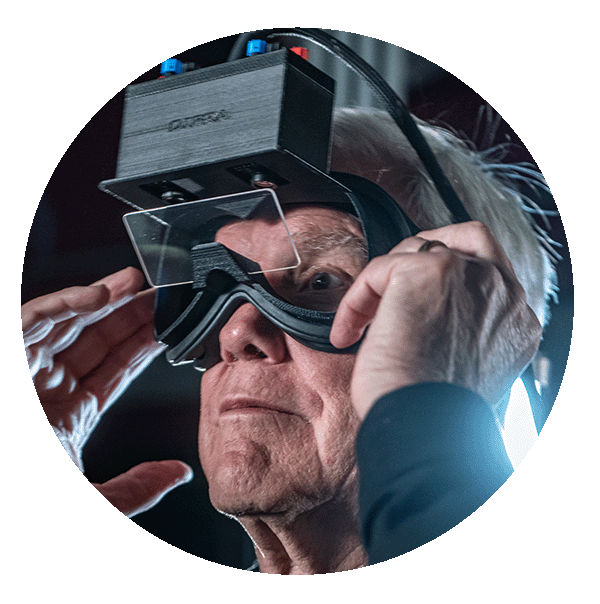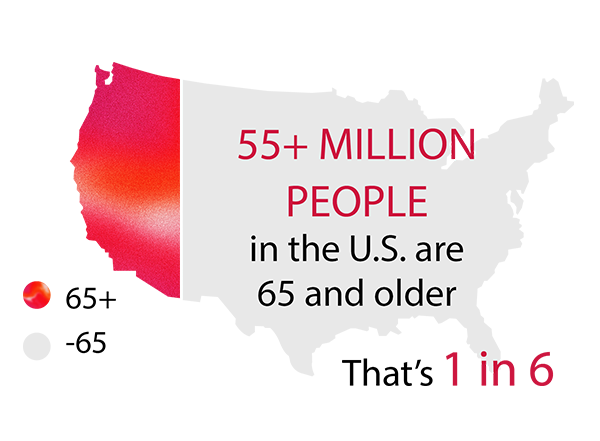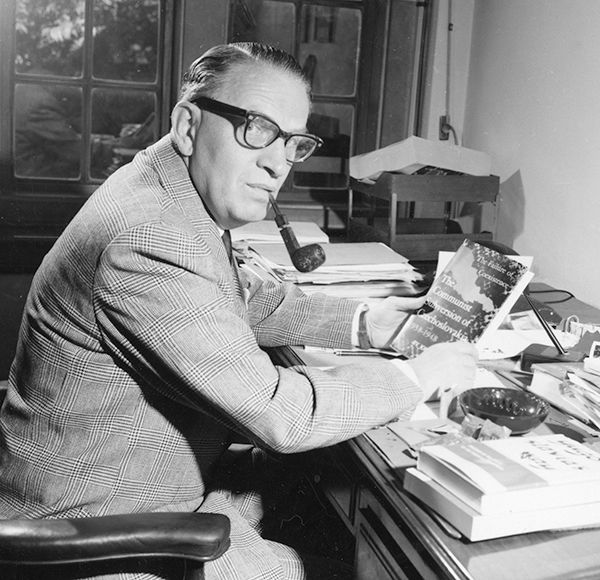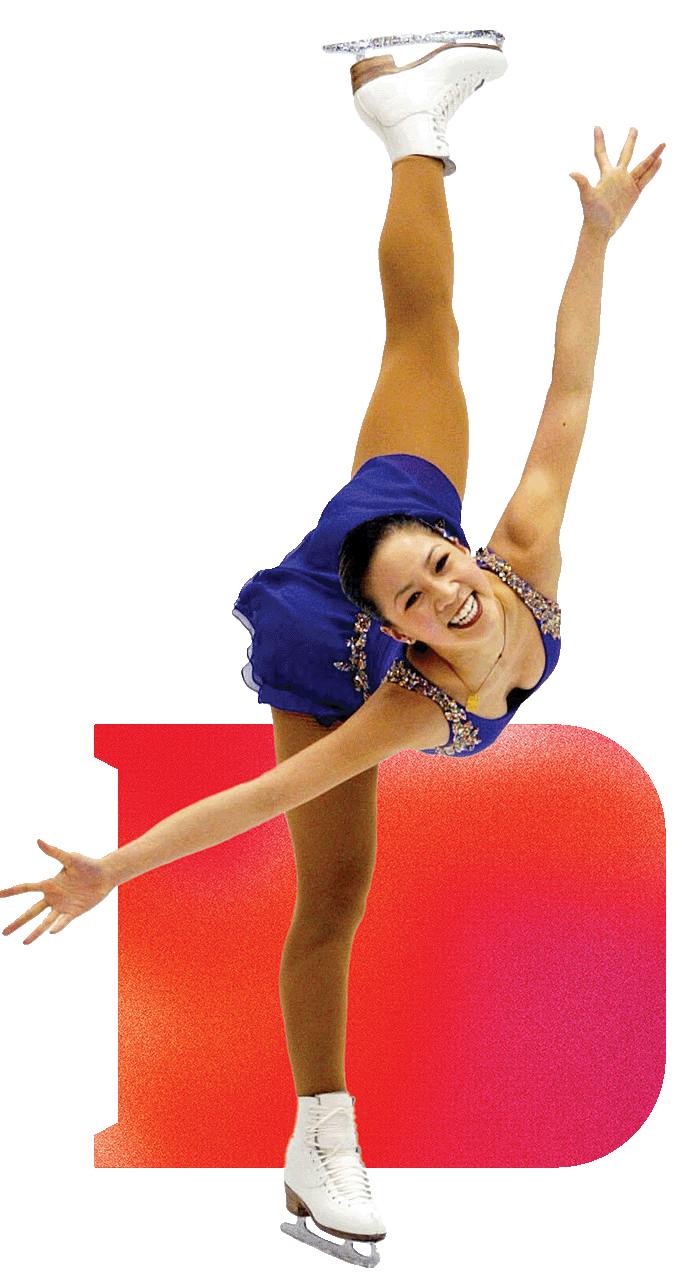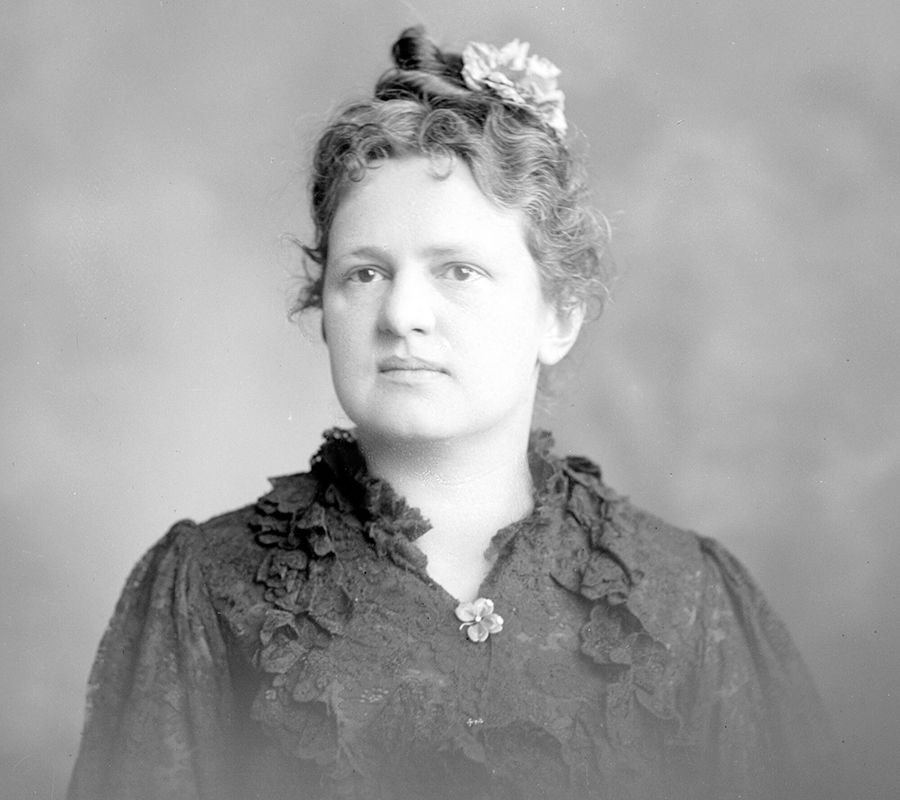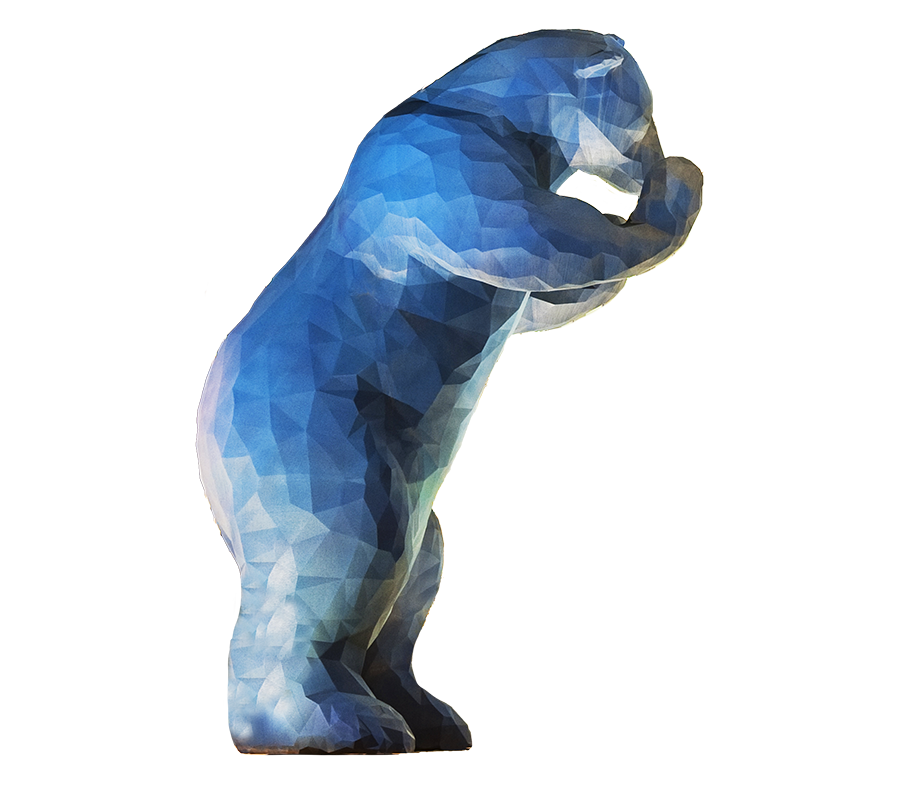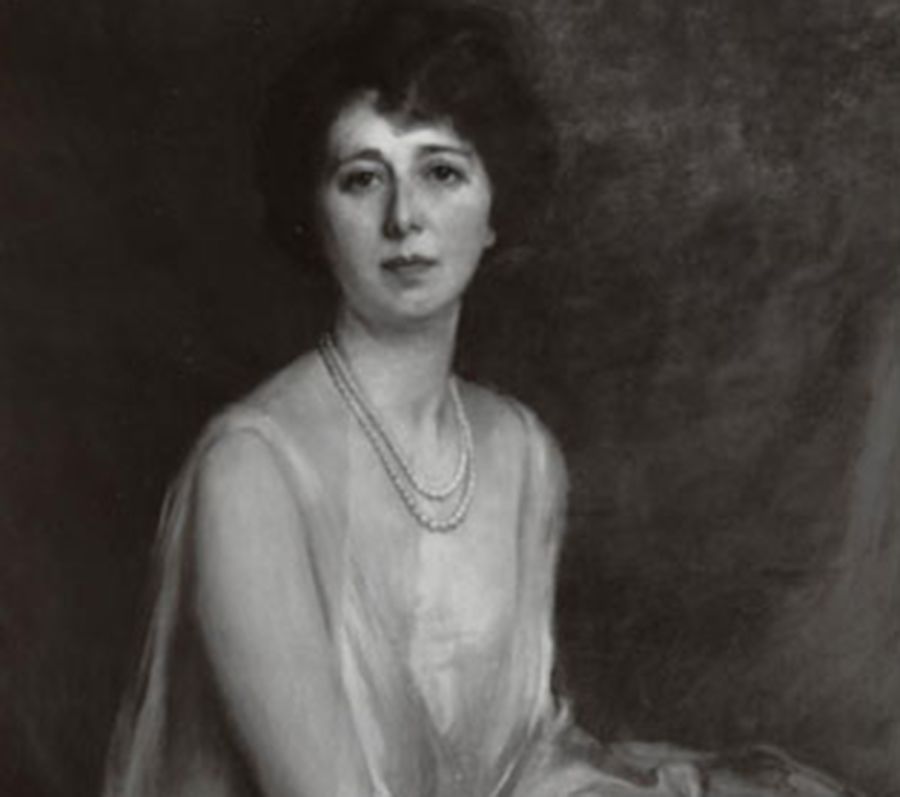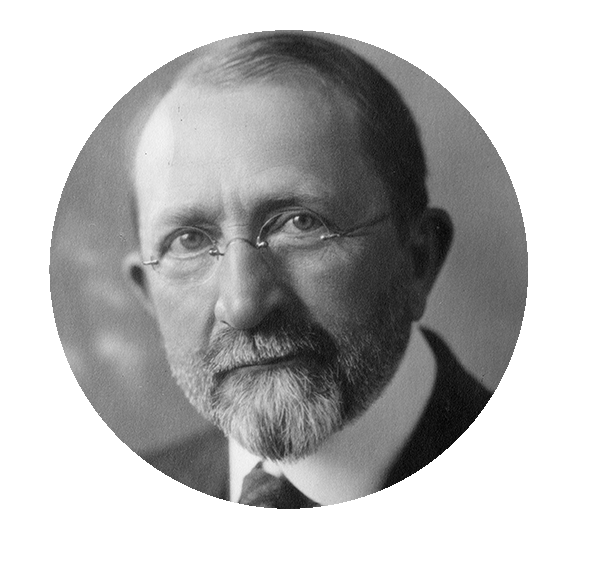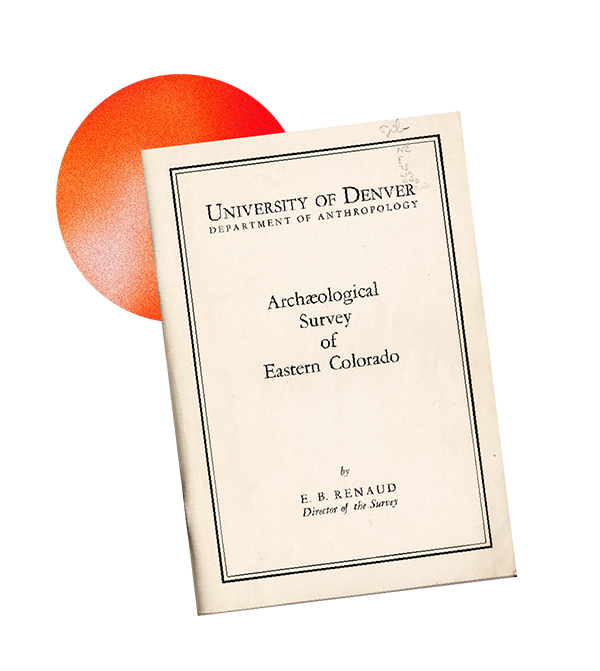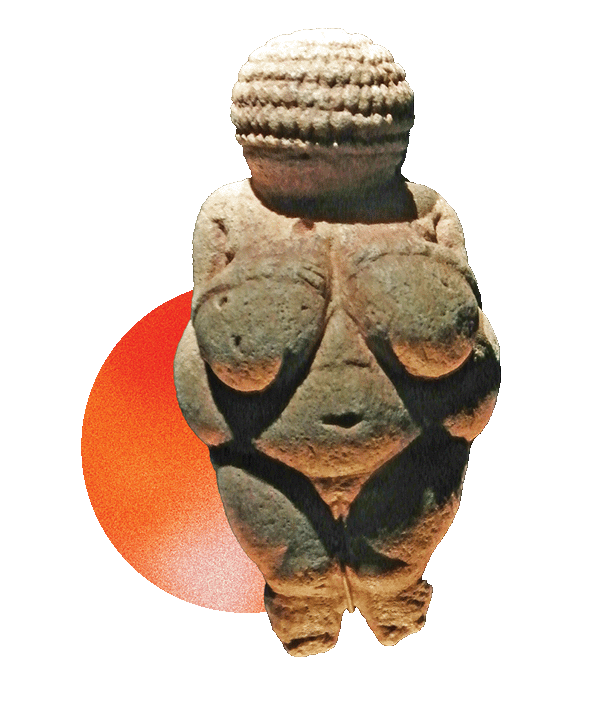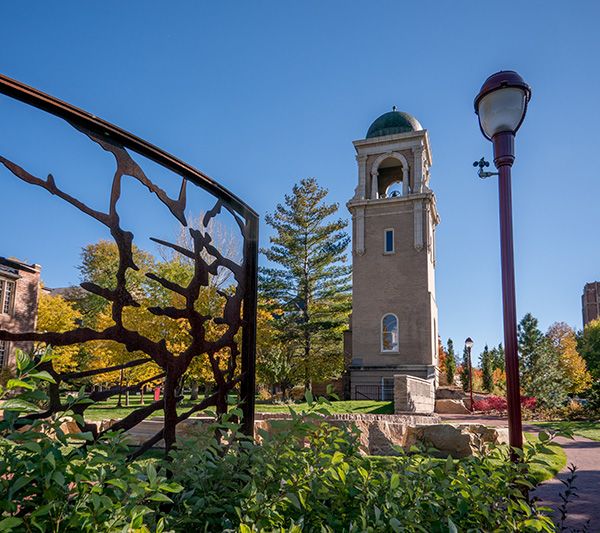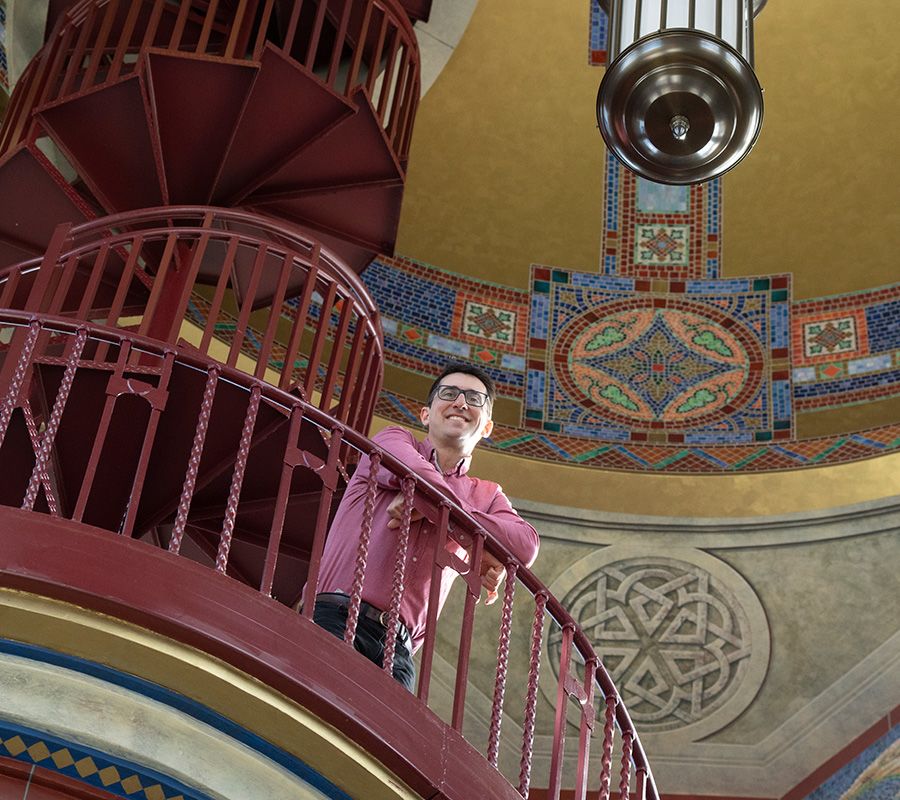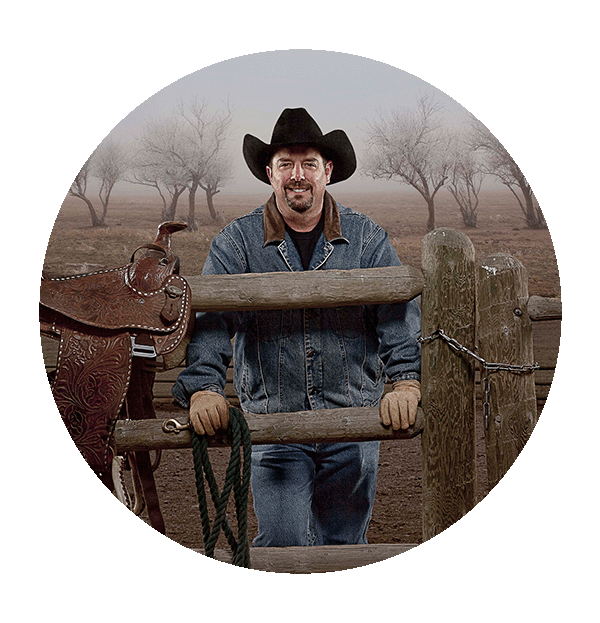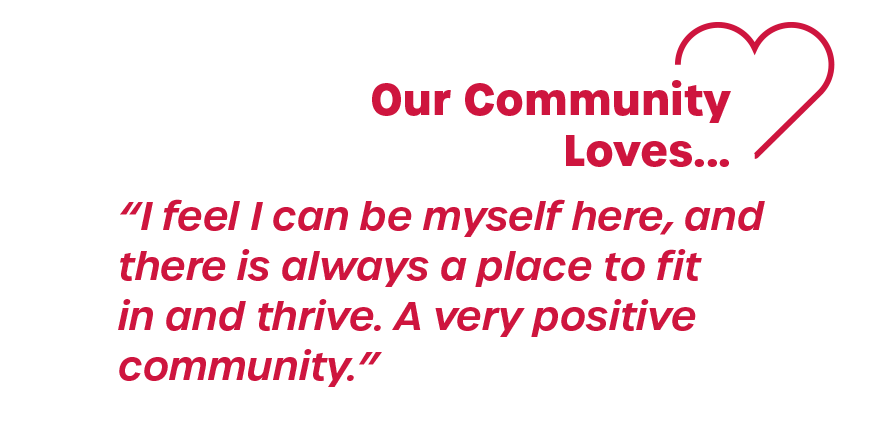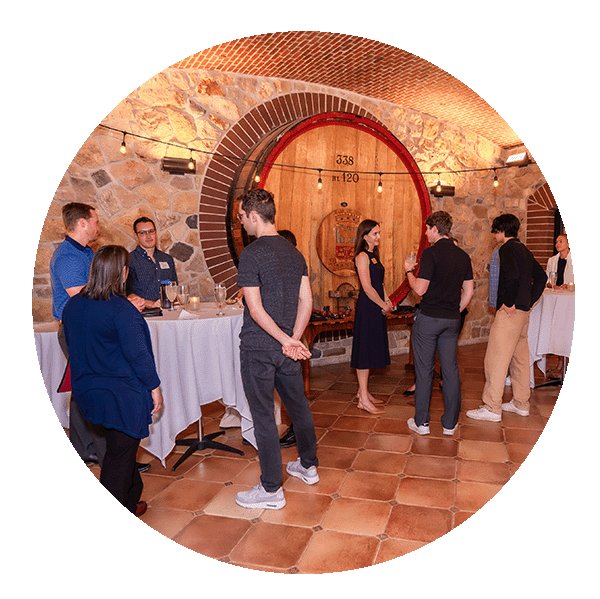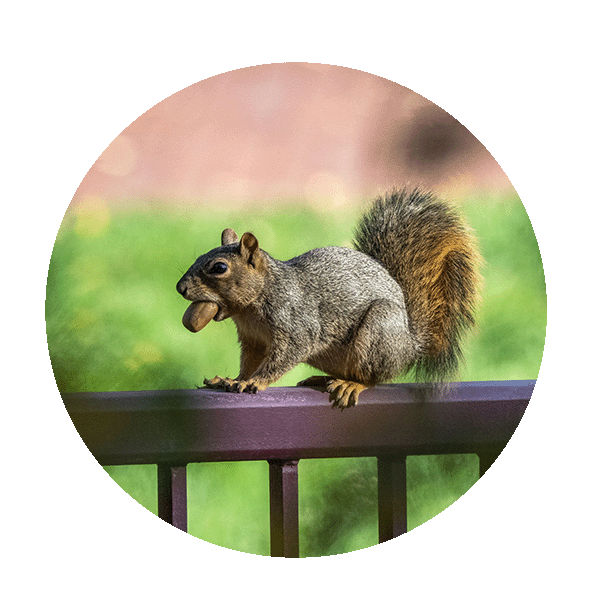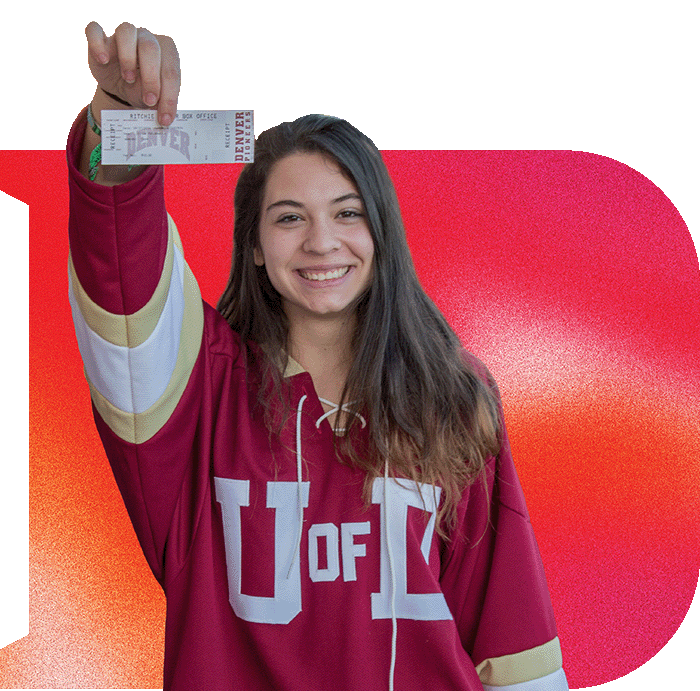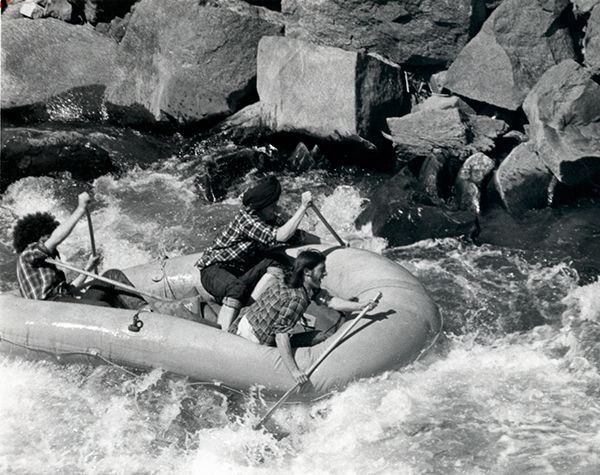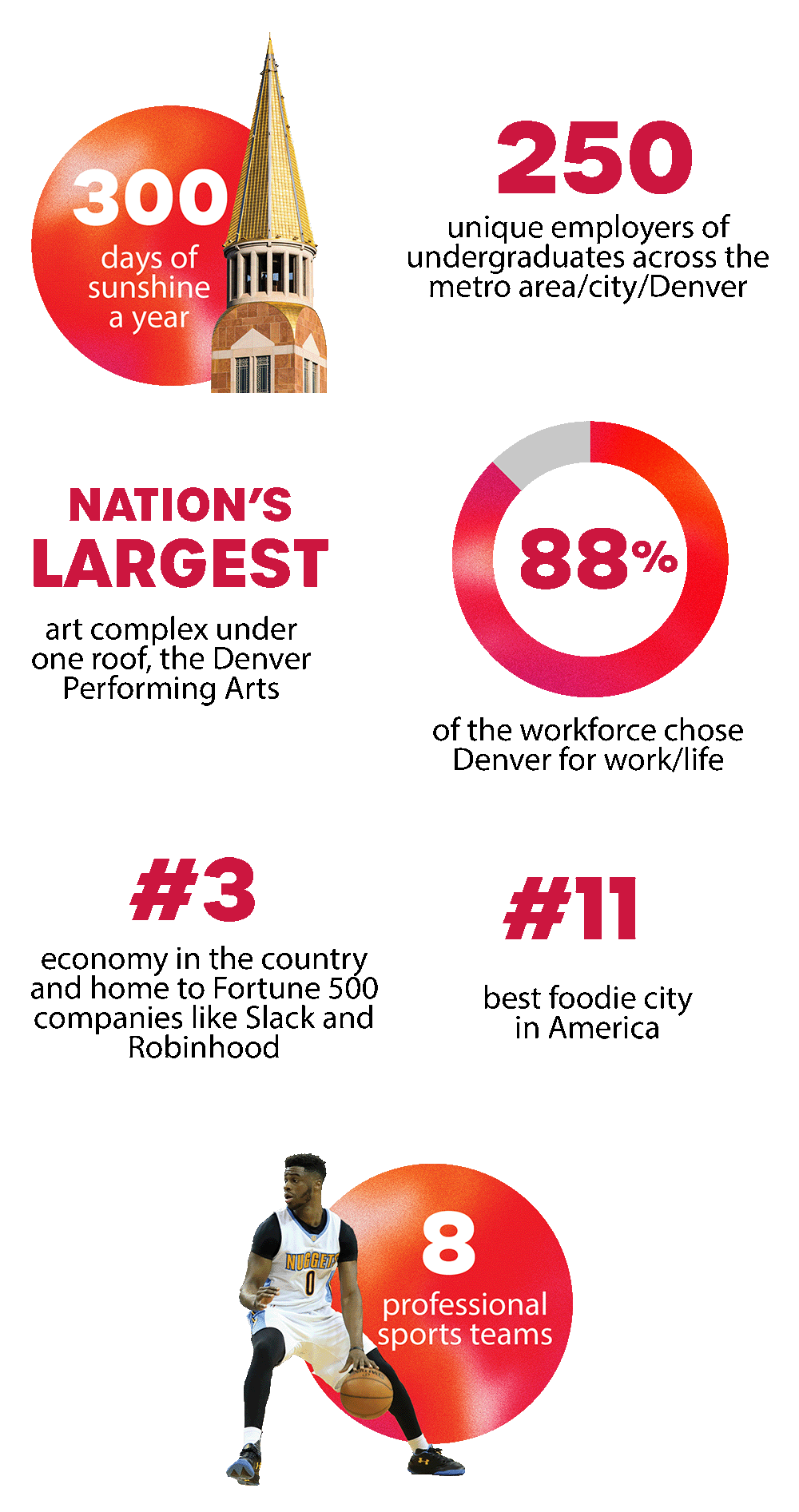50 Reasons to
Love DU
As we look to the future, we celebrate the people, places and programs that make DU exceptional.
Graphics by Kelsey Evans | Web design by Erin Bannon
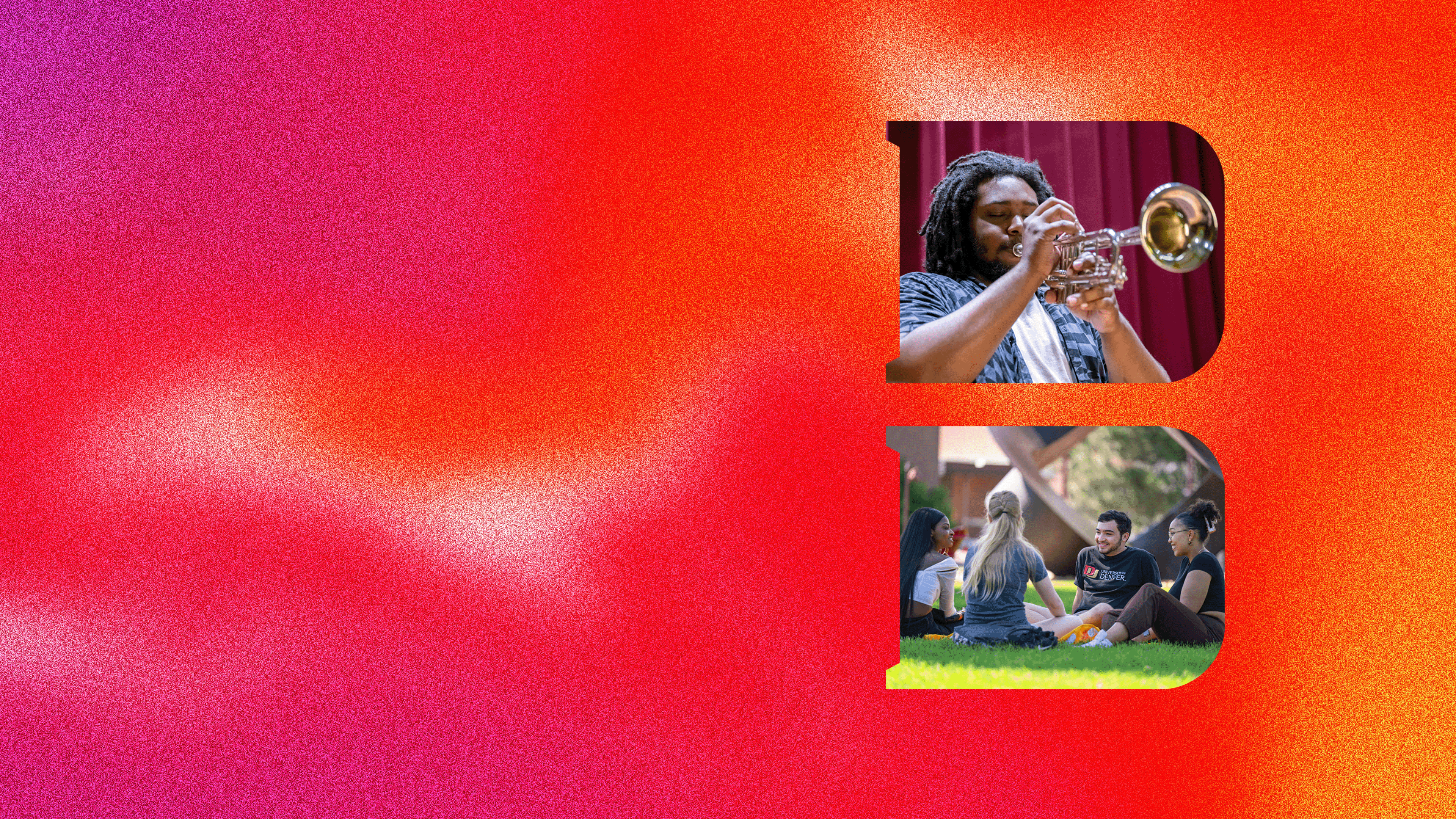
#1
WE’VE GOT GOOD DNA
This year marks DU’s 160th birthday. With that many years under our belt, DU’s got some good DNA—and we are so proud of the difference that the University and our alumni are making in Colorado and beyond. Check out these impressive stats:
#2
LEARNING FROM 0 TO 100
From infants and toddlers at Fisher Early Learning Center and middle schoolers at Ricks Center for Gifted Children to students from all walks of life working towards undergraduate and graduate degrees, the ages of our students range from zero to 94-year-old Steve Winber, who not only takes classes but also teaches them, including, rather ironically, “Gen Z: Super-Connected, Over-Protected, Socially and Morally Hypersensitive.”
#3
A Holistic College Experience
When DU launched its Four-Dimensional (4D) Experience in 2021, the goal was to “re-invent the college experience” by intentionally harnessing DU’s strengths—to focus not only on academics but on
the whole student. Now, incoming students live 4D from the moment they step on campus, with the help of a constellation of mentors who guide them in choosing classes, activities and experiences that nurture their intellectual growth, career development, character and well-being. By the time they graduate, they’re ready to embark not only on fulfilling careers but also lives of purpose.
"4D is about what students want to do and be. Do they want to study abroad? Do internships? Conduct research?Run marathons? We prompt them to map out how and when they can have these signature experiences—and provide ways for them to reflect on those experiences and see their progress."
#4
It's Beautiful Here
A 125-acre haven in the middle of the buzzing Mile High City, DU’s main campus has it all: stately brick and stone buildings from the turn of the last century; sun-filled modern buildings with sweeping views and artistic touches; the historic urban forest that makes up the Chester M. Alter Arboretum; landmark spires and towers; and plenty of serene spots to sit and study or just relax, both inside and out. Consistently ranked as one of the country’s most beautiful campuses, we have no doubt this was a factor when Princeton Review ranked DU 1st in the nation in 2024 for “these students love their college.”
“The DU campus is so beautiful! I love the campus in the fall as the leaves are changing and in early June when the campus is full of flowers and graduation excitement. These are my favorite times to host international delegations and show them the beauty of our urban campus.”
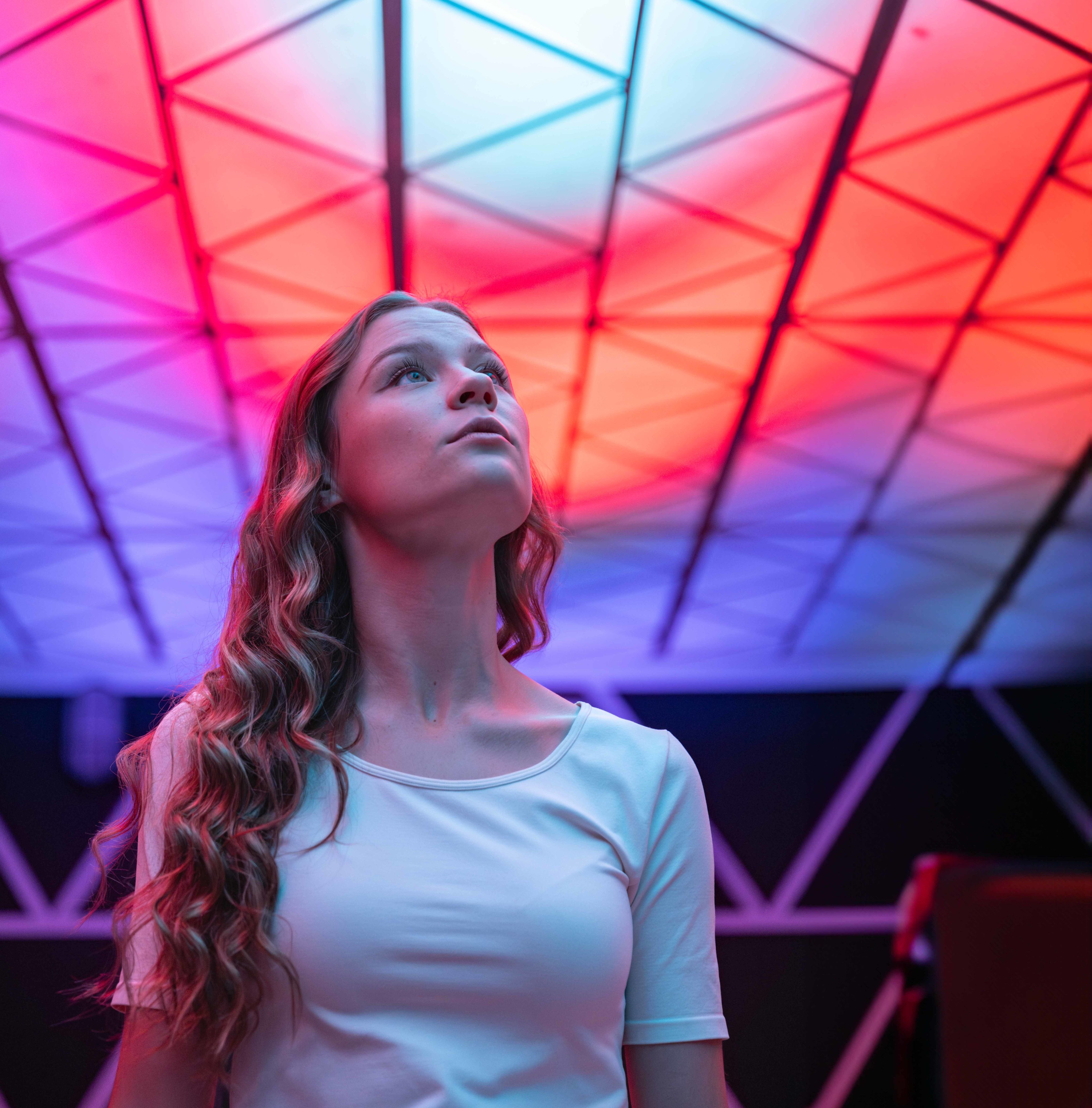
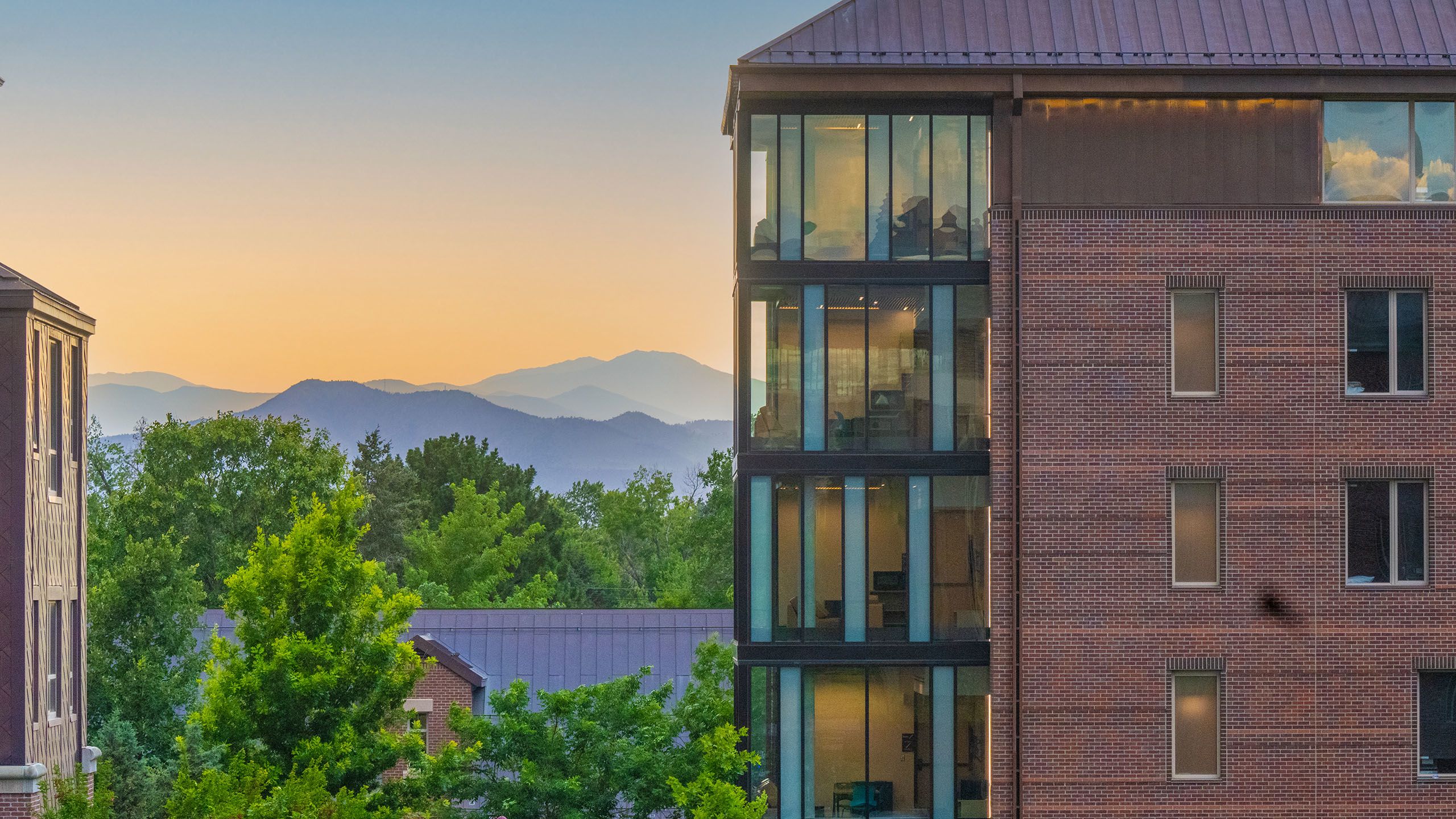
#5
THE OUTDOORS ARE OUR SPECIALTY
Skiing, mountaineering, camping and other outdoor adventures generate $37 billion in consumer spending annually in Colorado and employ more than half a million people across the state. DU’s first-of-its-kind Leadership in Outdoor Recreation Industry (LORI) program combines public policy, law and business coursework to develop current and next-generation leaders and increase the diversity of the talent pipeline in the outdoor industry.
#6
WE TAKE OUR SPORTS RIVALRIES SERIOUSLY
Before the Colorado College hockey rivalry began in 1950, there was the 1919 War of the Mines. When DU still had a football team, our archrival was the nearby Colorado School of Mines. In the early morning hours on Nov. 6, 1919, four bombs went off on campus that blew out 100 windows in University Hall, the Iliff School of Theology, Carnegie Library and Memorial Chapel.
Mines students were blamed, but no one was criminally charged. Some DU students retaliated by trying to repaint the large “M” on Mount Zion in crimson, but they were caught by Mines students, who took them back to their campus, shaved their heads and painted an “M” on their bald heads with silver nitrate. All involved went free, though, after the Denver Police Department threatened to cancel the upcoming game between the two teams should any additional issues be reported.
#7
AND THE EMMY GOES TO...
Lights, camera, winning! Whether it’s directing or acting, set design or costuming, students in the Department of Media, Film and Journalism Studies are creating innovative, imaginative cinema day in and day out—and they’re being recognized for it. In 2022, a filmmaking team in a capstone class snagged the first-ever Student Production Award from the Heartland Emmy Chapter for their short film, “The Bird of Paradise.” But it’s not only students—alumna Stephanie Filo (BA ’06) has won three Primetime Emmy awards for film editing for “The Black Lady Sketch Show” and, in 2023, became the first female editor in history to be nominated for three different projects in one year.
#8
EMPOWERING WOMEN, THEN AND NOW
Incorporated in 1888, the groundbreaking Colorado Women’s College merged with DU in 1982 and, in 2004, the renamed Women’s College moved into the brand-new Merle Catherine Chambers Center for the Advancement of Women. Though disbanded in 2020, the college’s legacy lives on through the CWC Leadership Scholars program for incoming undergrads and the women-centered organizations housed in the Chambers Center today: the Women’s Foundation of Colorado, the Women in Engineering ProActive Network (WEPAN) and Higher Education Resource Services (HERS). The Chambers building itself is also a legacy—designed, funded and built by women, including University architect Jane Loefgren, it features a signature nautilus motif, symbolizing a lifetime of growth.
#9
WE LOVE ANIMALS
Elevating the interrelationships of humans, animals and the environment is the work and passion of the Institute for Human-Animal Connection. Recently named one of six new DU Research Institutes, IHAC focuses on therapeutic human-animal interactions, animals in communities and conservation social work.
Recent projects include studying how interacting with farm animals can improve student outcomes in the classroom; the effects of a dog training program on incarcerated individuals; and how to increase access to veterinary care in historically marginalized communities.
#10
NEWMAN CENTER PRESENTS
Over the last two decades, the Newman Center has become a staple in the Denver arts community, showcasing performances by unique artists, storied singers and talented dancers from all across the globe. Vocal powerhouses like John Legend and Idina Menzel have graced one of Newman’s four performance spaces, which boast not only world-class acoustic construction but also uniquely intimate theatre environments. Known for its traditional and contemporary jazz and dance performances, its mission is to add more global acts each year.
#11
RECIPES THAT LIVE FOREVER
Food trends like avocado toast or matcha may come and go—but not for the library archivists managing University Libraries’ Cookery and Foodways Collection of 15,000 cookbooks. Here, recipes live forever, including your mom’s questionable tuna casserole, a menu from one of Bill Clinton’s state dinners and boiled pigeon from a British cookbook dating back to 1695.
#12
So. Many. Championships.
Our athletes know how to win. DU programs have won 35 NCAA national championships across 18 varsity sports. We’re all familiar with the continued success of our men’s hockey team—who now have the most national championships of any collegiate hockey program at 10—but what you may not know is that our ski team also sits atop the NCAA’s most titles list (24).
Visit du.edu/kingsofhockey to relive hockey’s 10 championship titles.
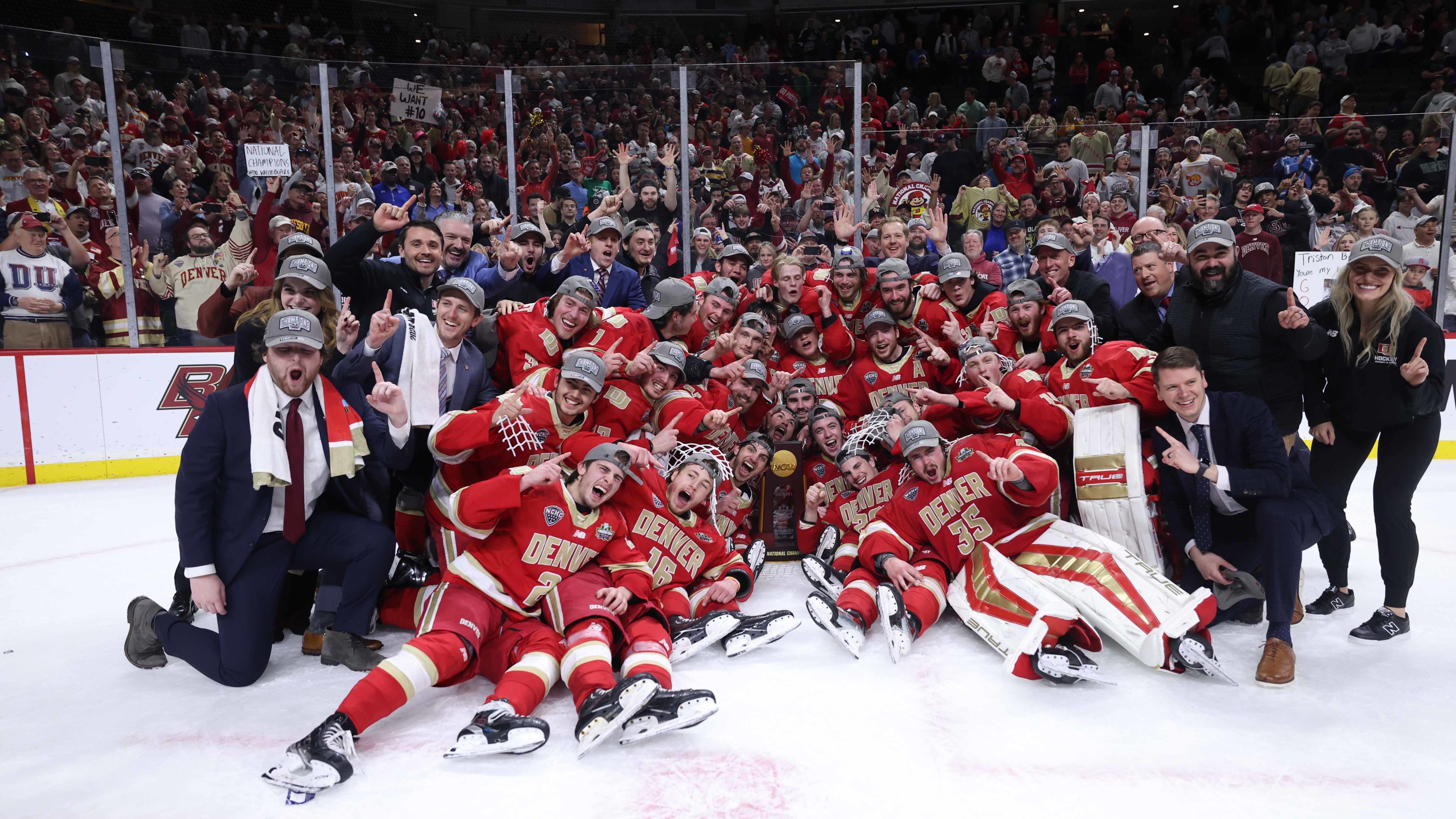
#13
TOP OF MIND
As part of a nationwide initiative to protect student mental health called JED Campus, DU is committed to comprehensive, data-driven mental health care. Our Thrive Peer Educators are students who serve as health and well-being “ambassadors” on campus and facilitate Intervene: DU, a required active bystander training for all undergrads. Beyond campus, the Western Colorado MSW program in Glenwood Springs addresses the dire need for mental health providers in rural areas, bringing education and training to where future social workers already reside and making a lasting difference in their communities.
#14
GOING, GOING, GONE
Seven out of 10 students study abroad during their time here. That’s thanks, in huge part, to the Cherrington Global Scholars Initiative, which financially supports students’ roundtrip international airfare and visa application fees. Undergrad and grad students alike have traveled to nearly every corner of the Earth, from Tokyo and Oxford to Costa Rica and Glasgow. What’s more, a litany of programs and partnerships across the globe provide faculty and staff the chance to further their careers abroad.
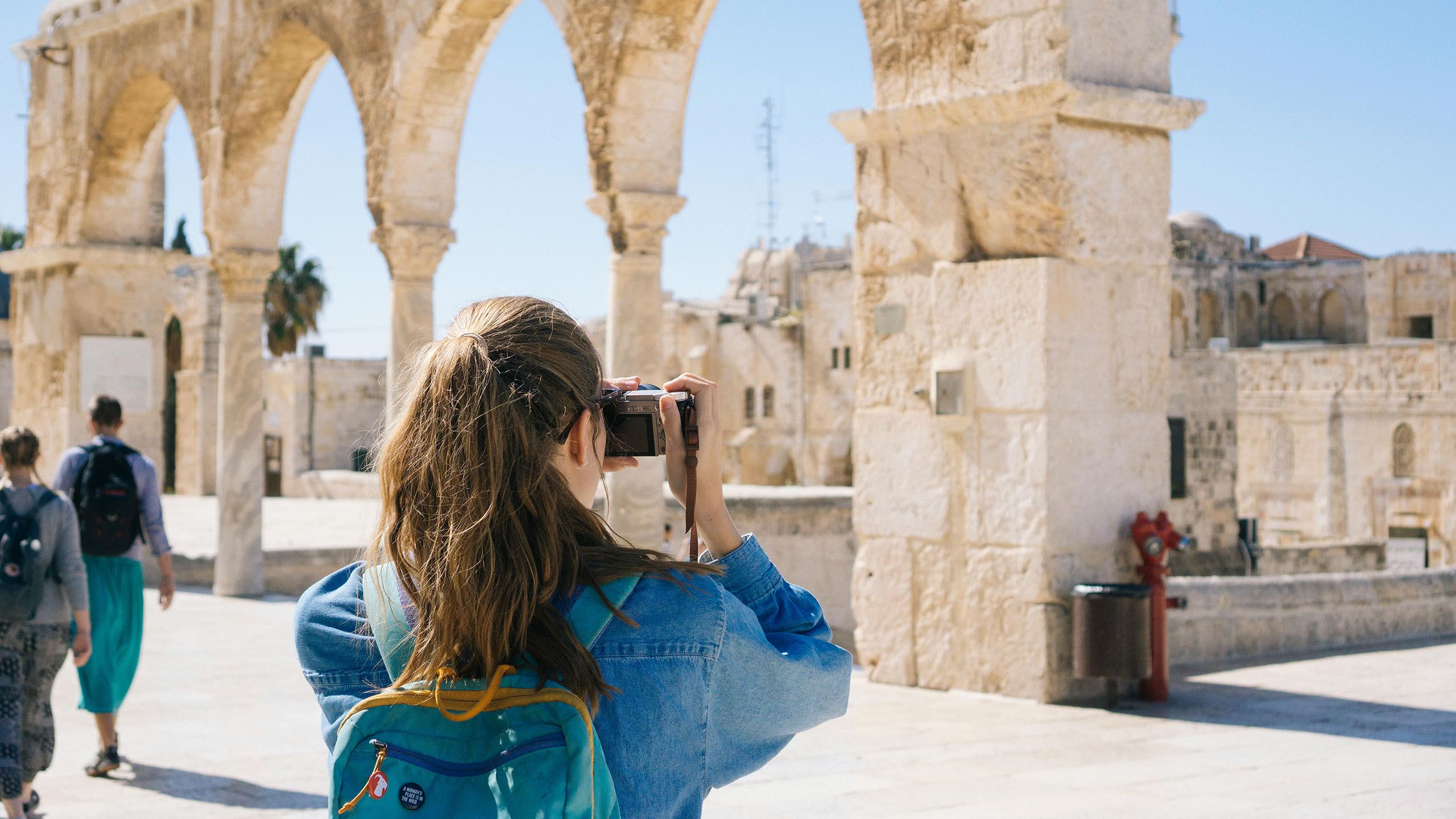
#15
PITCH PERFECT
Since 2012, more than 400 first-year business students have taken the Madden Challenge, developing and pitching their best ideas in a Shark Tank-like environment to a panel of judges made up of successful entrepreneurs, business experts and investors. Funded by a donation from the late John Madden Jr., a local real estate developer, the Challenge rewards winning teams with prize money to fund their startups.
#16
THE FIRST IN LEGAL AID
The University of Denver College of Law opened its legal aid dispensary in 1904, creating the first clinical program in the nation. A frontrunner in serving Denver’s indigent populations, the student law office trains students in the practice of law under the supervision of experienced faculty, while at the same time serving the underserved communities in criminal defense, civil practice, civil rights matters, immigration and environmental law.
#17
WE HAVE OUR OWN FLOWER
Not every university can say they have their very own flower. The DU Rose, also known as “Rosa Denvera,” got its start when the University received a rose bush as a gift in 1912. DU botanist Ira Cutler discovered the blossoms were unlike any others, so he used the original specimens to develop a distinct crimson-and-gold variety—descendants of which are planted throughout campus.
#18
MUSIC TO THEIR EARS
At DU, music is a two-way street—drawing audiences from across Denver but also bringing music to the community. Musical Explorers, a collaboration of the Newman Center, Denver Public Schools (DPS) and Carnegie Hall, is a semester-long program that teaches second graders about diverse musical traditions like hip hop, Gullah and Chicano funk. The free program includes teacher professional development, curriculum, digital resources and in-class visits from local and international artists—culminating in an interactive concert at the Newman Center. “The kids know all about these artists and have learned all the songs, so they come so excited to sing and dance along. It’s just joy, personified,” says Executive Director Aisha Ahmad-Post. More than 3,000 students participated in 2023-2024.
#19
39,500 LINEAR FEET OF BOOKS—AND SO MUCH MORE
Ranked No. 1 in the country for “Best College Library” by The Princeton Review in 2023, Anderson Academic Commons is a world-class library and student services center that packs in 2,000 seats (each with its own power outlet), 32 group student rooms, 39,500 linear feet of library collections onsite, two cozy fireplaces and 4,000 pieces of furniture refurbished and reused from the beloved Penrose Library—including the iconic egg chairs, where students have studied (or napped) for decades.
University of Denver Penrose Library, 1972. Credit: DU Special Collections.
#20 The Denver Difference
At the University of Denver, we took a good, long look at the future of higher education and thought: We can do better.
So, we’re challenging conventional thinking. We’re doing higher education our way. Holistically. We’re developing the whole student, focusing on intellectual growth, life purpose, character and well-being. We’re redefining the promise of higher education. Preparing a new kind of leader and world citizen for what’s ahead. Solving problems and creating new knowledge that directly improves the human condition. Because young people coming up deserve a better future. And what DU can do will help them to solve the toughest challenges they face.
True to our Rocky Mountain West can-do spirit, we’re rolling up our sleeves to do the hard work of making a difference now. With open hearts and minds, we’re actively solving complex societal problems through visionary leadership, research, scholarship and strong partnerships. We are grateful for your interest and support as we set the new standard for higher education in the 21st century. This campaign is the turning point that establishes our approach as the model to match. It makes transformation possible—and raises everyone’s hopes for the future. We’re The Denver Difference. Let’s show the world what DU can do.
Listen to the Campaign Story read by Chancellor Jeremy Haefner.
Powered by Philanthropy: Things We Love About DU
Gifts made during the quiet phase of The Denver Difference are transforming our University.
Opening the Door for the Next Generation of Difference Makers Through Scholarships
An anonymous, transformational gift greatly expands resources available to first-generation students through FIRST@ DU, which supports scholarships and programming so first-generation students can thrive at DU. The Saunders Leadership Academy, founded by Former DU trustee Joseph Saunders (BSBA ’67, MBA ’68, Hon. PhD ’09) and his wife, Sharon, supports promising students burdened by significant financial need. Since 2018, it has supported 15 students in their journey to becoming the next generation of leaders. The Tomé Scholars—funded by Carol (MBA ’81, Hon. PhD ’18) and Ramon Tomé, provides scholarships, mentoring and networking programs that ensure student success in the Daniels College of Business. Cohort-based scholarship support programs, funded by organizations like the Davis New Mexico Scholarship, the Daniels Fund and the Boettcher Foundation, connect and support students who share similar characteristics.
Preparing for Careers and Lives of Purpose
The Burwell Center for Career Achievement, made possible through the generosity of Barbara Burwell, her late husband, Rod, and their three sons, Peter (BSBA ’11), Blake (BSME, MBA ’15) and Michael (BA ’16, MBA ’17), is DU’s home for career and professional development support and alumni programming. Outstanding career preparation at scale is a cornerstone of the 4D Experience. DU ranked #23 in the Princeton Review for Best Career Services, and more than 90% of graduates report having jobs or enrolling in an advanced degree six months post-graduation.
Join us today as we create the future of DU. Be The Denver Difference. denverdifference.org

#21
WE REACH FOR THE STARS AND SKIES
Built in 1894, the Chamberlain Observatory, with its 20-inch Clark-Saegmuller refractor telescope, has permitted students, faculty and astronomers to gaze at celestial bodies for more than a century. Home to the Denver Astrological Society since 1945, biweekly public nights offer amateurs and experts alike a chance to peer into the night sky.
Long before the James C. Kennedy Mountain Campus became a part of DU’s footprint, the Mount Blue Sky Field Station (formerly the Mount Evans Field Station) was the original campus in the mountains, dating as far back as 1937. Historical physics research and theories, including a better understanding of the universe and cosmic radiation, were developed there—not only by DU but also by visiting universities including the University of Chicago, Cornell, MIT, NYU, Princeton and the University of Michigan. In 2017, the field station was recognized as part of the American Physical Society Historic Sites Initiative. Still operated by DU, the facility is available year-round for use by academic groups and individual researchers interested in the geology or ecology of the Front Range.
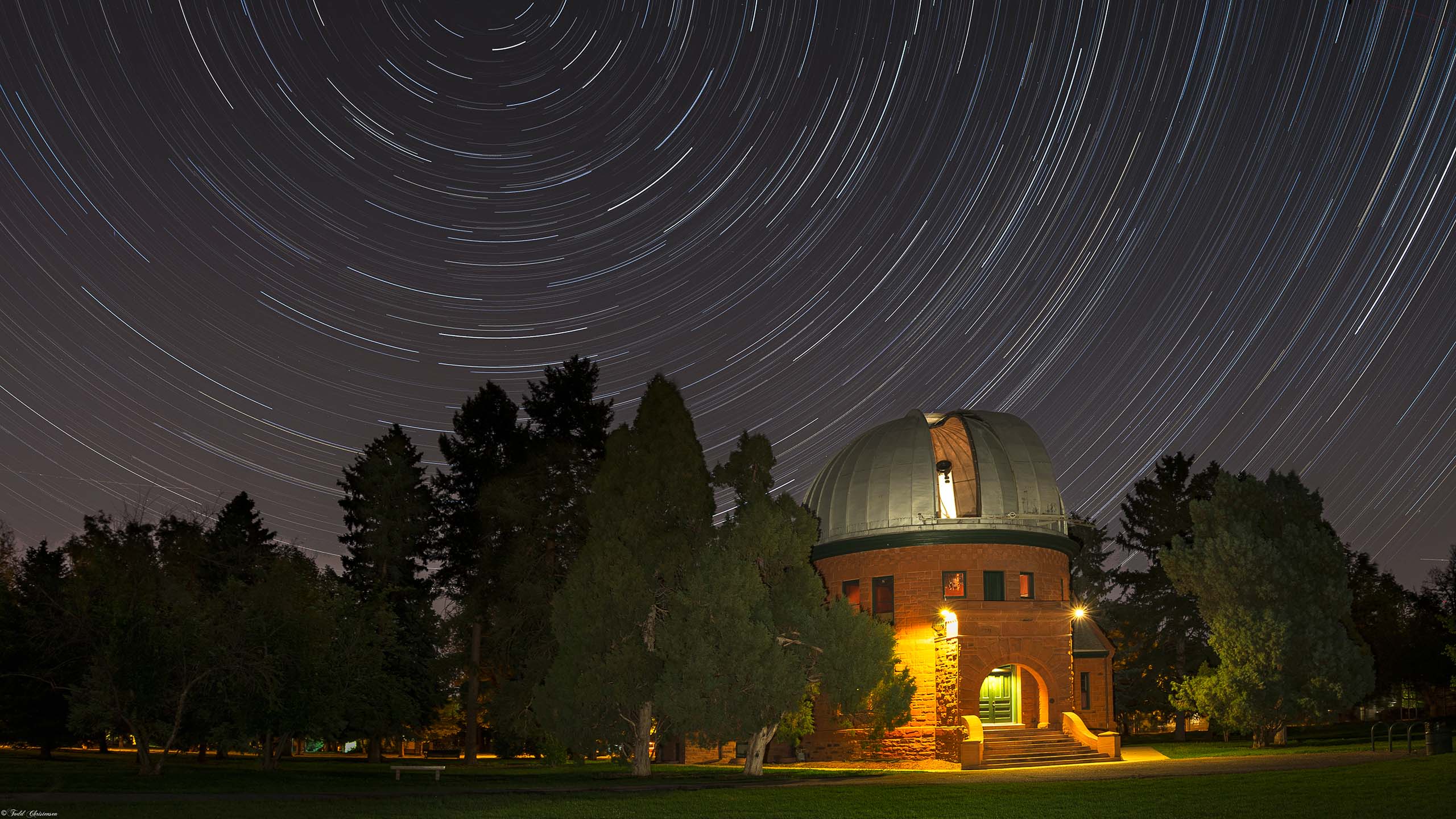
#22
SONGS THAT HEAL
Music helps us express and understand our emotions, thoughts and experiences—and it can also help restore us. Through the Lamont Voices Making Impact program, voice majors work on community service projects, including a partnership with Children’s Hospital of Colorado, in which they perform for hospitalized children and their families. Read more about the the Lamont Voices Making an Impact program at du.edu/voicesmakinganimpact.
And the Spirituals Project, a community choir open to all, is charged with revitalizing the sacred songs created and first sung by enslaved Africans in the U.S. in the 18th and 19th centuries.
#23
COMMITTED TO COMMUNITY
Our faculty and students are committed to improving the lives of Colorado resident and communities, from the Ready for American Hospitality for newly arrived refugees and University College’s Business Development certificates for immigrant entrepreneurs to mutual aid for migrant families organized by the Graduate School for Social Work and the partnership between the Center for Housing and Homelessness Research and the Denver Basic Income project to boost the financial stability of the unhoused.
#24
CELEBRATING 60
The world has changed a lot in the last 60 years, and the students, faculty and staff of the Josef Korbel School of International Studies have been there to witness it all. Korbel was founded in 1964 by Josef Korbel—father to the late Secretary of State Madeleine Albright—under whose leadership the field of international studies was changed forever. Notable alums include the first U.S. ambassador to the African Union, Cindy Courville, former Chief of Staff of the United States Army Gen. George W. Casey Jr., and former Secretary of State Condoleezza Rice, who has said that she and Albright shared the same “intellectual father” in Korbel, who mentored her during her time at DU. The Korbel School is home to 13 unique research institutes, centers and clinics, including the Frederick S. Pardee Center for International Futures: A Research Institute and the Scrivner Institute for Public Policy—two internationally renowned research and policy hubs.
Josef Korbel, 1957. Credit: DU Special Collections.
#25
INNOVATIONS IN HEALTHY AGING
The Knoebel Institute for Healthy Aging (KIHA) is exploring all aspects of aging to improve the odds of growing old in a healthy way. Assistant Professor of Molecular and Cellular Biophysics Sunil Kumar and his lab are working with researchers in KIHA and across campus to develop and test potential treatments for Parkinson’s disease. KIHA’s Paul Freeman Financial Security Program is discovering new ways to combat financial fraud and abuse among aging populations. Professor Mohammad Mahoor developed Ryan, an emotionally intelligent robot designed to assist people with Alzheimer’s and dementia. KIHA also partners with local institutions to spread Alzheimer’s awareness and connect community members with resources. At the height of the COVID-19 pandemic, KIHA researchers tested a novel antibody test, enabling its emergency use authorization by the FDA.
#26
OLYMPIC GLORY
As more than 10,000 athletes compete in the 2024 Summer Olympics in Paris, don’t be surprised if you see a familiar face on your television screen. More than 100 current and former Pioneers have competed in the Olympics since the 1948 Winter Games in St. Moritz, Switzerland—including Paul Stastny (men’s ice hockey), Kevin Dineen (men’s ice hockey and women’s ice hockey coach), Katie Hensien (alpine skiing), Jessica Lopez (gymnastics), Nick Shore (men’s ice hockey), Craig Patrick (men’s ice hockey coach), Simona Castro (gymnastics), Wilhelm “Willy” Schaeffler (skiing coach) and so many others.
Alumna Michelle Kwan (BA ’09) performs during the Winter Olympics 2002. Credit: Zuma Press, Inc. / Alamy Stock Photo
#27
WE'RE GOING GREEN
Unlike a famous frog once quipped, it is easy being green! At least, DU is making it look easy. Since 2006, we’ve reduced campus greenhouse gas emissions by 43%, and we’re on pace to cut our carbon footprint by more than 70% by 2026. The Center for Regenerative Futures educates students on how to live more sustainably while also contributing to a low-waste, regenerative campus community through the DU Thrift Store, the Food Pantry, the Green Garage and Move-Out/Move-In Day sales of gently used student items. Sustainability is everywhere you look, including the LEED-certified Burwell Center for Career Achievement and the Sturm College of Law building (the first law school in the nation to receive a LEED gold certification). And we can’t forget about an actual green feature on campus: The copper dome on the Buchtel Tower, which is more than a century old. The Kermitcolored copper is 100% recycled and recyclable!
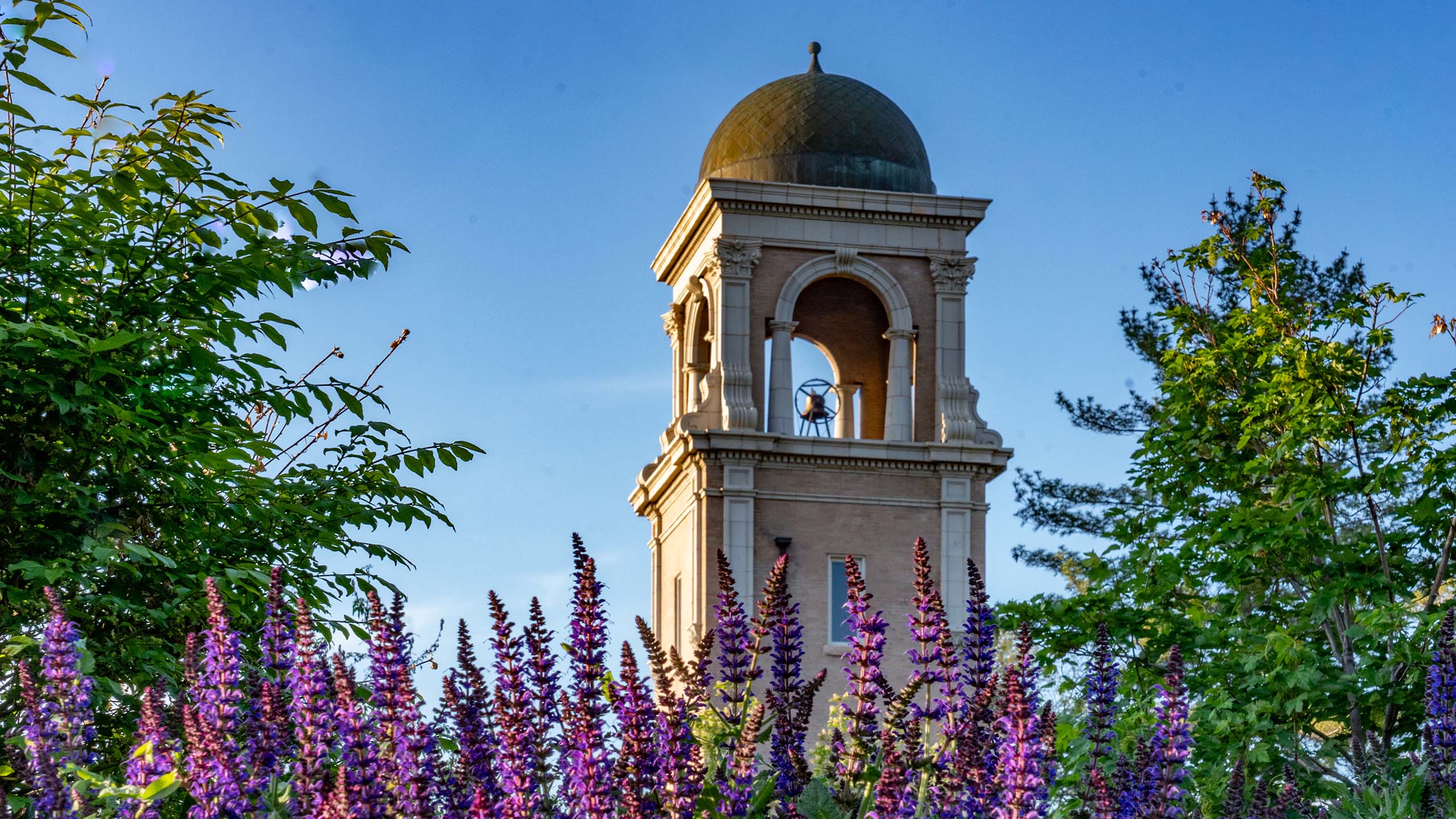
#28
FEMALE LAWSTARS
The first woman lawyer to be admitted to practice before Colorado’s United States District Court and the U.S. Court of Appeals is alumna Mary Lathrop, who graduated from the then-named DU College of Law in 1896. And in 1941, DU broke gender boundaries again when it hired Helen Thorp, the first full-time female faculty member in the nation.
Mary Lathrop by Rose & Hopkins, 1886-1901. Credit: Denver Public Library Special Collections H-6.
#29
ART FOR THE PUBLIC GOOD
“I have no tolerance for mediocrity or for the student who refuses to work.” That’s an infamous quote from a famous former director of the University of Denver School of Art, Vance Kirkland, whose paintings hang in more than 15 museums across the world. Kirkland isn’t the only hardworking artist with DU ties—have you seen the Big Blue Bear in downtown Denver? That signature piece is thanks to none other than former professor emeritus Lawrence Argent, who also designed “Whispers,” the concrete sculptures of lips near the Ritchie Center. Painter and muralist Allen Tupper True and sculptor Ed Dwight also once called DU home.
“I See What You Mean” by Lawrence Argent. Credit: VISIT DENVER
#30
THE GHOSTS OF DU
Night owls, beware: There may be more than just insomniac scholars frequenting the halls of campus buildings after dark. Phil Goodstein’s (MA ’75) book, “The Ghosts of University Park, Platt Park and Beyond,” digs into the eerie history of several buildings on campus—Mary Reed’s Renaissance Room and the historic Buchtel House among them. The list of haunted premises also includes Margery Reed Hall, former home of the DU Theatre Department. “[Hundreds of performers] over the years have all been convinced there’s a ghost,” Goodstein says. “They claim strange whispering and odd echoes during performances; things were always slightly going wrong.”
Portrait of Mary Reed
#31
"CRUSHING IT" FOR RURAL FAMILIES
Since 2018, the Center for Rural School Health (CRSHE, pronounced “crush”) in the Morgridge School of Education has partnered with schools and communities across Colorado to improve health and education outcomes. In line with their vision that all children, youth and adults in rural communities should live healthy and meaningful lives, CRSHE takes on projects like WERCS (Wellbeing and Equity in Rural Colorado Schools), a five-year effort to help 31 rural school districts develop and implement strategies that promote well-being and mental health for youth and staff.
#32
MORE WINTER, PLEASE
To love DU is to love winter. At the first sign of snow—sometimes as early as October—you’ll see snowmen, igloos and snowball fights all over campus. DU First Snow rings in the new season with pop-up giveaways (often a cozy hat or a scarf) and chances to warm up with a cup of hot cocoa. Students take full advantage of the winter conditions any chance they can by skiing, snowboarding and sledding on the hill on the north side of the Ritchie Center and, during particularly heavy storms, thrill seekers have been known to try their luck at the dangerous (and illegal) “sport” of car skiing. Each winter, students also come together to enjoy Winter Carnival, a week of on-campus events capped off by a weekend of high-altitude fun. The first carnival took place at Winter Park in January 1961, just days after DU announced the end of its football program and coinciding with the NCAA skiing finals. Cancelled only three times in six decades, Winter Carnival has earned its spot as one of DU’s most beloved traditions, offering a much-appreciated mid-quarter break.
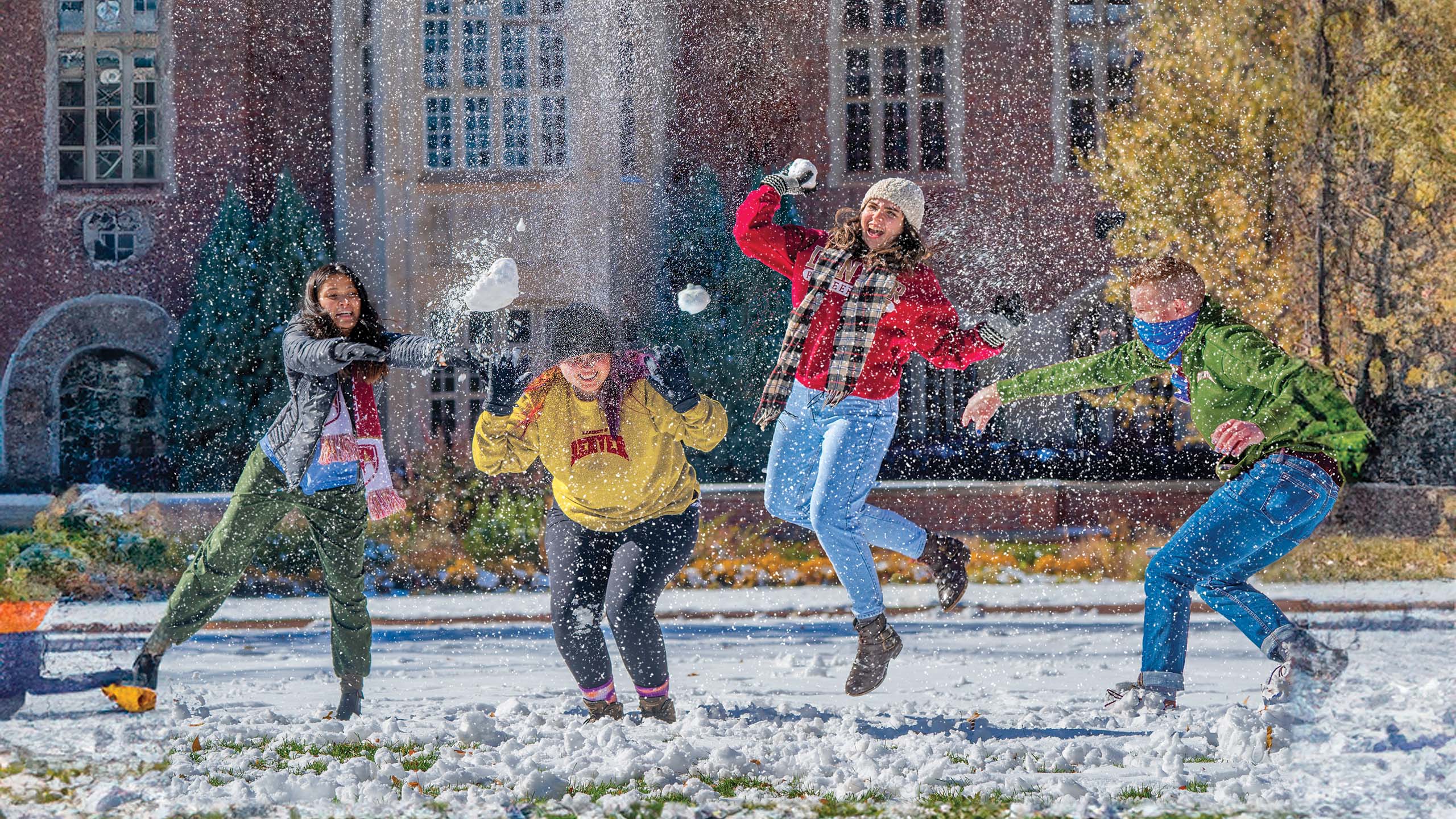
#33
RESEARCH WITH REACH
1880
Herbert Alonzo Howe arrived in Denver by train to begin his work as one of six professors, teaching DU’s first astronomy class in 1881. As the first director of the Chamberlin Observatory, Howe contributed significantly to research on Mars and other heavenly bodies.
1920
Etienne B. Renaud was the first archeologist to complete a systematic study of Eastern Colorado. He was foundational in developing survey methods of the western High Plains and wrote approximately 125 articles for both American and European publications.
1936
Fred D. D’Amour developed serum to neutralize the venom of black widow spiders.
1945
Joyce C. Stearns was one of seven physicists who signed the Franck Report, recommending the nuclear bomb developed by the Manhattan Project at Los Alamos Laboratory not be dropped on Japan. Later, Stearns became faculty and chair of the physics department at DU and worked with Denver City Parks on building the paved road to the top of Mount Blue Sky.
1968
PhD student Ezekiel Mphahlele, considered a founding writer of modern African literature, was awarded First Prize for best African novel by African Arts magazine for “The Wanderers,” an autobiographical novel he wrote in in lieu of a thesis.
1987
Inventor and chemist Donald Hugh Stedman along with research engineer Gary Bishop developed the FEAT (fuel efficiency automobile testing) system. The automated system could test up to 10,000 vehicles per day, using a costefficient method that surpassed traditional testing stations in identifying polluting automobiles.
1990s
Sarah M. Nelson’s studies of ancient art— specifically, the famous Venus figurines of Ice Age Europe—demonstrated how interpretation of the past reflected contemporary cultural and political biases. She was among the first to focus on the archaeology of gender and laid the foundation for feminist archaeology.
2019
Jennifer Greenfield studied and authored a report on the potential economic impacts of paid family leave in Colorado. She also testified at the state Legislature numerous times in support of Colorado’s Family and Medical Leave Insurance Program (FAMLI), which voters approved in November 2020.
2023
Galena Rhoades and Scott Stanley’s research indicates that, contrary to popular belief, living together before being engaged can decrease a couple’s odds of a successful marriage.
#34
"HERE I AM"
The Holocaust Memorial Social Action Site, designed under the guidance of DU architect Mark Rodgers, is an outdoor gathering place to honor and remember those who lost their lives in the Holocaust. The memorial features a central stone bench shaped like the Hebrew word for life, “chai,” and an amphitheater of stone benches for a wide range of gatherings. The metal lattice partitions, located at the entry of the site, are intended to emulate shattered glass as a reference to Kristallnacht and spell out the Hebrew word “hineni,” which means “Here I am.”
#35
WE'RE IN CLASSROOMS NATIONWIDE
From Philip Strain’s LEAP preschool model, an inclusive classroom environment for children with autism, to Julie Sarama and Doug Clements’ decades of research on making math accessible to all young learners, the influence of the Morgridge College of Education extends across the nation, reaching hundreds of thousands of young students. In addition, the Volunteers in Partnership (VIP) program, coordinated by the Office of Student Affairs, connects DU students with local high school students to offer support and mentoring as they finish high school and transition to college or career.
#36
THE BELL TOLLS FOR THEE
The 65 bronze bells atop the 215-foot Williams Tower make DU’s carillon the fifth largest instrument in the country. The carillonneur, after trekking up 95 grueling and oftentimes windy steps, must possess graceful hands and nimble, strong legs to play the 20- to 12,000-pound bells. The resident carillonist, Joey Brink, is known to play a variety of tunes, even Taylor Swift songs.
#37
FANTASTIC FSEMS
Professor Keith Miller typically teaches analytical chemistry courses, but students in his first-year seminar (FSEM) faced a unique challenge to earn a passing grade: keeping their captain afloat. Students voted on their final assignment—building boats out of cardboard and duct tape—before making their maiden journey across the Ritchie Center’s El Pomar Natatorium.
Read more about DU’s best FSEMS at du.edu/7fsems.
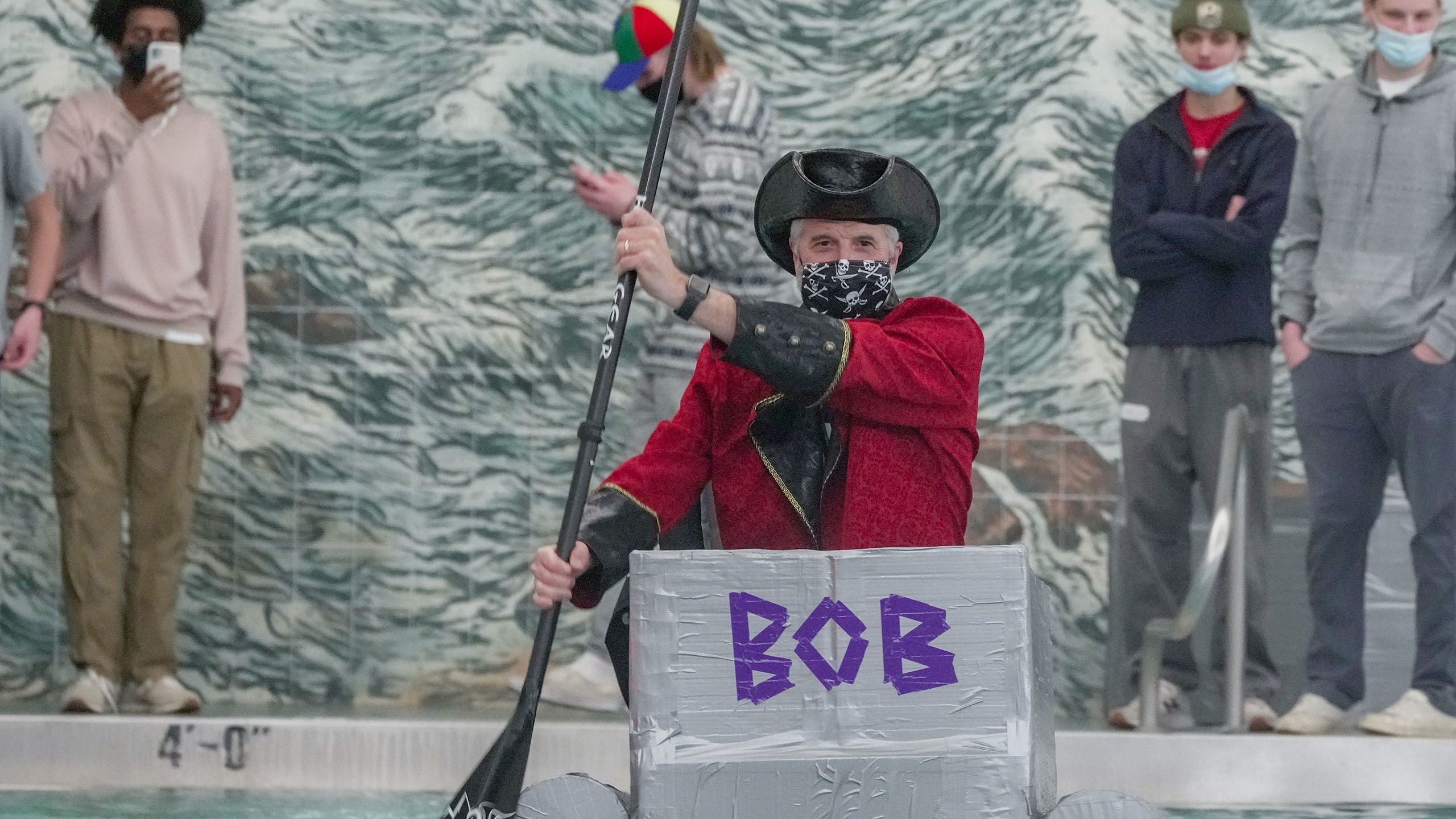
#38
SMALL BUT MIGHTY
The Graduate School of Professional Psychology (GSPP) made its mark as one of the first programs in the country to offer a doctorate in clinical psychology. Though the program is not one of the largest, it is certainly active—in the last decade, GSPP has conducted more than 250,000 service hours and served more than 4,500 clients through its seven on-site training clinics. The school also runs the only state-licensed community health clinic that doubles as a department-run training clinic. It’s one of the largest training clinics in the U.S.
#39
BESTSELLERS, WESTERN STYLE
From American West literature expert and professor Levette J. Davidson in the 1920s to bestselling “Go as a River” author Shelly Read in 2023, faculty and alumni have a long, proud connection to fiction and nonfiction set in the West. C.J. Box (BA ’81) has written more than 30 novels which have sold more than 10 million copies, including the popular Joe Pickett crime series about a Wyoming game warden.
Sandra Dallas (BA ’60) has written 18 novels, five YA novels and 10 nonfiction books, including the New York Times bestsellers “Prayers for Sale” and “True Sisters.” The work of former English professor John Edward Williams is finding new audiences 30 years after his death with the 2023 release of a Nicolas Cage movie based on his book “Butcher’s Crossing.” And John R. Erickson, who attended DU in the late ’60s, is a cowboy-writer whose “Hank the Cowdog” series is one of the most popular children’s series of all time, having sold more than 7.5 million copies and found in most school libraries across the U.S.
#40
DRONES, DEVICES AND SIMULATORS, OH MY!
Over their entire fourth year, small teams of engineering students are mentored by faculty and industry sponsors to create innovative products and services to help solve the realworld problems facing a variety of industries. Projects have included an automated cat toy, a ski treadmill, a hydraulic-powered bicycle, multipurpose drones and a system to train individuals on adaptive technology— just to name a few.
#41
WORKERS WALLS
On many of our campus’ stunning buildings, the University celebrates the craftspeople who built them by listing the names of every person who contributed their time, talent and expertise in alphabetical order, without regard to whether they were a structural engineer, the mason who set bricks or the signalperson who made sure those entering the construction site wore the correct safety gear.
#42
WOMEN CHANGING THE GAME
When the first women’s varsity teams were sanctioned in 1974, all five were led by female coaches— and, in the 2023-24 season, we have eight female head coaches, the most in the University’s history: Alicia Hicken-Franklin, men’s and women’s swimming and diving; Julianne Sitch, women’s soccer; Doshia Woods, women’s basketball; Martha Richards, women’s golf; Melissa Kutcher-Rinehart, women’s gymnastics; Liza Kelly, women’s lacrosse; Barbara Perkins, women’s triathlon; and Megan Pendergast, women’s volleyball.
#43
OPEN ACCESS
“It was always about making it as useful as possible for as many people as possible, even if we don’t know how they’re using it,” said Thor Andreassen (PhD ’23) of the biomechanics research that he and professor Kevin Shelburne published in the DU Digital Commons, where students and faculty from all corners of campus share their discoveries with the world. And over in the Ritchie School, professor Kerstin Haring is leading a collaboration with other universities to develop the Sustainability Hub, a platform for researchers, activists and policymakers alike to share and make use of health, well-being and sustainability data.
#44
OUR HOME AWAY FROM HOME
The urge to go higher just got easier at the James C. Kennedy Mountain Campus with the newly built via ferrata course. “Via what?!” Common in Europe and increasingly popular in the States, a via ferrata is an accessible alternative to rock climbing, allowing harness-clad climbers to clip into cables, bolts or other assistive devices as they ascend or traverse steep terrain. And what’s more, Reed Rowley, partner and director of business development of the Estes Park-based Via Ferrata Works, who designed and built the via ferrata, is currently pursuing a master’s degree in real estate and construction management at the Daniels College of Business.
At more than 8,000 feet in elevation, the 720-acre Kennedy Mountain Campus near Red Feather Lakes in northern Colorado is home to experiential, place-based learning alongside endless trails, ropes courses and rocks for climbing.
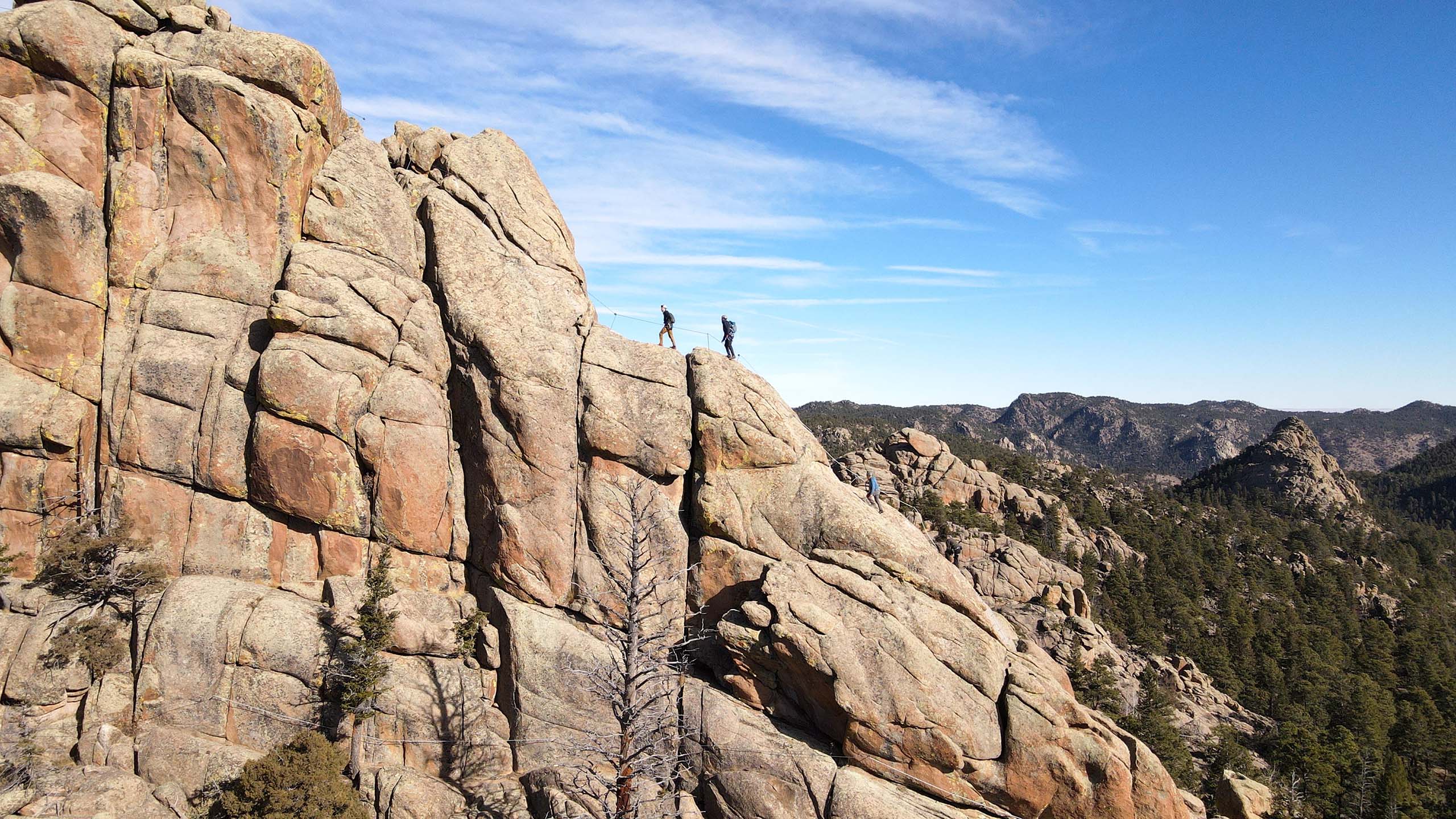
#45
BETTER WITH AGE
The University’s Tuscan-style wine cellars, tucked away in the lower level of the Joy Burns Center, train the next generation of sommeliers in all things viniculture. Students in the Fritz Knoebel School of Hospitality Management get a chance to learn the ins and outs of fine wine, from grape varietals and growing conditions to tasting and serving, while picking up certifications along the way. Hospitality students show off their acumen at the annual DU Vin wine tasting and dinner, pairing food from Denver’s finest eateries with more than 150 unique wines.
#46
OUR FURRY FRIENDS
Perched on the west porch of the Newman Center for the Performing Arts, thespian statues carved in stone wear bunny slippers, paying homage to the furry campus regulars. Theatrically, the bunnies’ faces are obscured by masks like those worn by actors in the Italian commedia dell’arte tradition. From bunnies to foxes to hawks, many creatures and critters make appearances on campus, but few are as regular as the rambunctious fox squirrel, whose squirrelly antics you can follow on Instagram @squirrelsofdu.
#47
"I'VE GOT A GOLDEN TICKET"
Hundreds of students have camped out each year near the Ritchie Center in hopes of getting their hands on the golden ticket—free DU hockey season tickets. With 10 national championships, seats in Magness Arena are a hot commodity. The tradition began in 2001 when the hockey coach purchased season tickets for the first two students in line.
#48
THE LONG AND SHORT OF IT
Aaahh, the quarter system. Only about 5% of colleges and universities have it, and we’re one of them. While students and faculty alike love the long break they get from Thanksgiving to early January, students also like the faster pace of their classes, opportunities to do interterm and summer courses, and the ease of double (or even triple) majoring. Because classes are offered more often, there’s more flexibility to fit them in and—maybe best of all—if you’re taking a class that you don’t particularly like, you’re done in only 10 weeks.
#49
MOUNTAINEERING SINCE 1928
The Alpine Club has been exploring the Rocky Mountains since 1928. With weekly ski trips, guided backcountry outings, rafting, and rock and ice climbing, the Alpine Club has certainly earned its spot as the University’s largest (400+ members) and longest running student club.
Alpine Club recreational river rafting, 1974–75. Credit: from DU Special Collections.
#50
LOCATION, LOCATION, LOCATION
At 5,280 feet, our skyline boasts mile-high views of the Rocky Mountains, rivaling campuses across the country for scenic beauty. Students especially remark on the views from Evans Avenue and the Mountain View Room on the fourth floor of Ruffatto Hall. But while it’s easy to love Denver’s views, there other advantages to learning and living in a world-class city (see below).
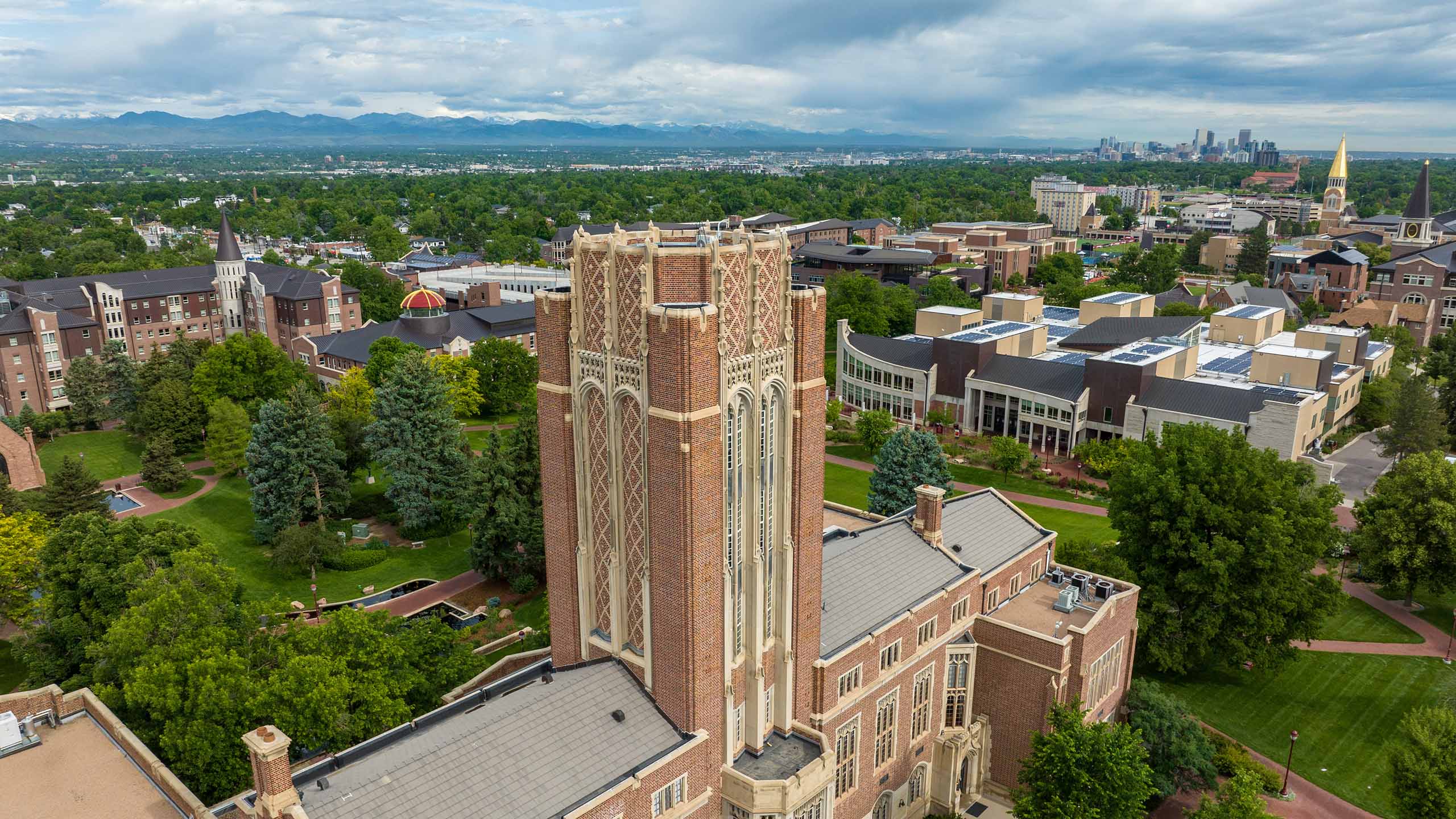
What did we miss?
Tell us your Reason to Love DU by emailing dumag@du.edu

